#give me a depiction of mary the fashion icon!
Explore tagged Tumblr posts
Text






Welcome to the style, you haven't seen in a while, it's Lavish
"I learned in [Queen Mary’s] court that she has already given up the superstitions that used to exist, that women should not wear gold or coloured clothing, as she and many of her company are adorned with gilding."
- Antoine Noailles to King Henri II of France, 7th August 1553
#mary i#mary tudor#tudor#give me a depiction of mary the fashion icon!#with all her ladies peacocking around#in her gaudy yellow dress!
12 notes
·
View notes
Text
MARILYN MONROE
June 1, 1926 - August 4, 1962
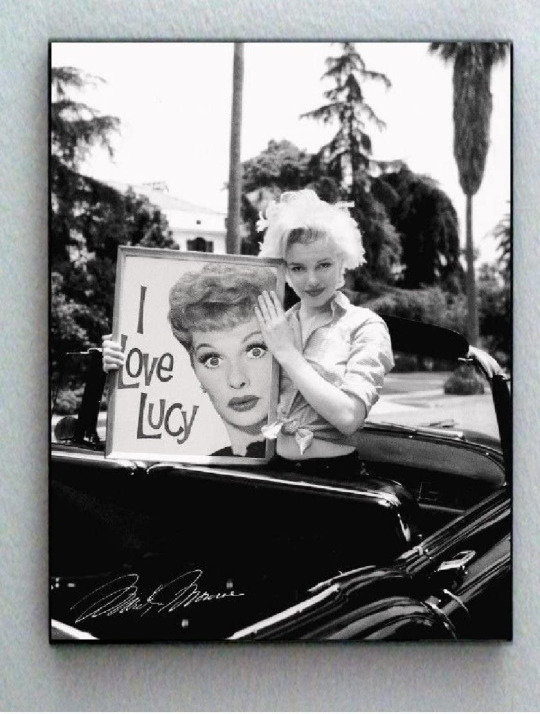
Marilyn Monroe (born Norma Jeane Mortenson) was an actress, model, and singer. Famous for playing comedic "blonde bombshell" characters, she became one of the most popular sex symbols of the 1950s and early 1960s and was emblematic of the era's changing attitudes towards sexuality. She was a top-billed actress for only a decade, but her films grossed $200 million by the time of her death in 1962. More than half a century later, she continues to be a major popular culture icon.
"When I was five I think, that's when I started wanting to be an actress. I didn't like the world around me because it was kind of grim, but I loved to play house. When I heard that this was acting, I said that's what I want to be. Some of my foster families used to send me to the movies to get me out of the house and there I'd sit all day and way into the night. Up in front, there with the screen so big, a little kid all alone, and I loved it.” ~ Marilyn Monroe,1962

Lucille Ball never worked with Marilyn Monroe, but meet her in 1953 at Ciro’s Nightclub on Sunset Strip, along with Betty Grable, and Red Skelton. Monroe’s immense popularity permeated Ball’s work none-the-less.
At the start of “Changing the Boys’ Wardrobe” (ILL S3;E10) the gang is heading to the movies to see “That picture we’ve been trying to get to for weeks with Marilyn Monroe.” The movie is likely Gentlemen Prefer Blondes, which premiered in New York City in July 1953. On November 5, 1953, the same day the episode was filmed, Monroe’s new film How to Marry a Millionaire was released in the US.
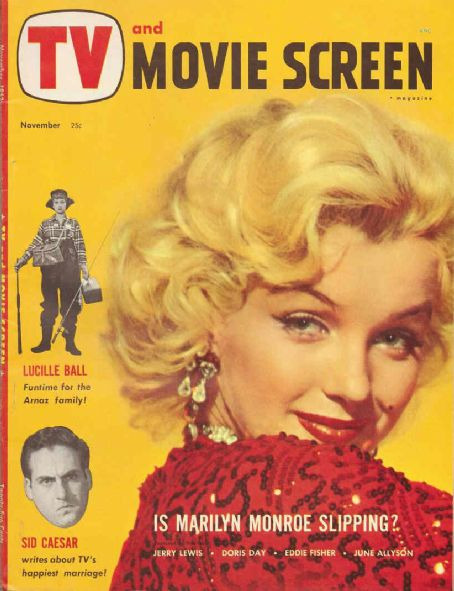
The November 1953 cover of TV and Movie Screen Magazine saw Lucy (in “The Camping Trip”) and Marilyn wearing the dress she wore on the May 1953 cover of Life Magazine promoting Gentlemen Prefer Blondes.
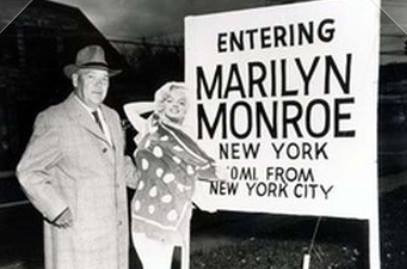
Also on November 5, 1953, the town of Monroe, New York (60 miles from New York City) was temporarily renamed Marilyn Monroe.

The film later inspired much of the plot of “Second Honeymoon” (S5;E14), Lucy’s failed attempt to make their transatlantic crossing to Europe more than just a working vacation.
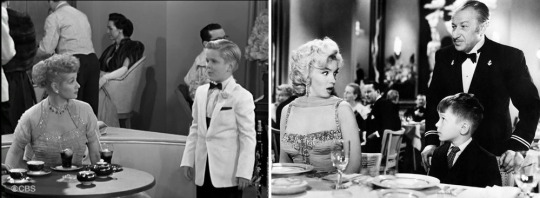
Monroe’s dinner companion turns out to be a seven year-old boy, just like Lucy’s ping pong partner turns out to be young Kenneth Hamilton (Harvey Grant).
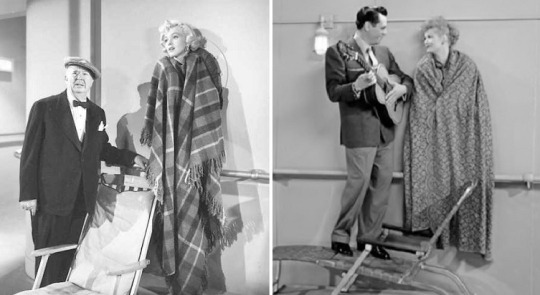
Lucy gets stuck in a porthole just as Monroe did, also draping a blanket around her shoulders so passersby wouldn’t know what was really going on.

The idea for the burlap potato sack dresses in “Lucy Wants A Paris Gown” (ILL S5;E20) comes from Monroe’s real life.
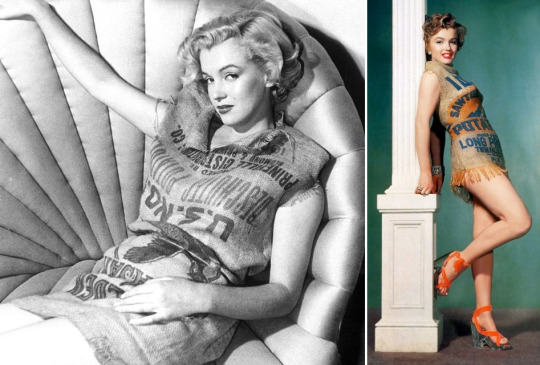
In 1951 Marilyn Monroe took a series of high fashion photographs wearing a potato sack as a response to a journalist who said that she might look sexier in a burlap sack than her usual fashion choices.
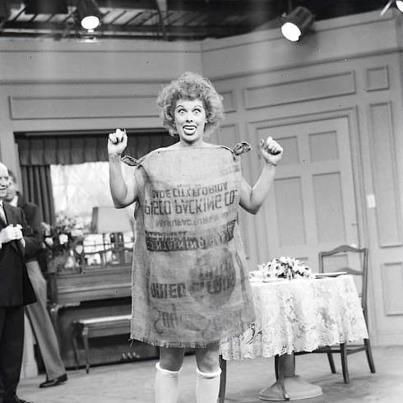
Lucy first wore burlap at the end of “Mr. and Mrs. TV Show” (ILL S4;E24) as her scary version of a Phipps make-over.

In “Ricky’s Movie Offer” (ILL S4;E5) Lucy and Ethel argue about who looks more like Marilyn Monroe.
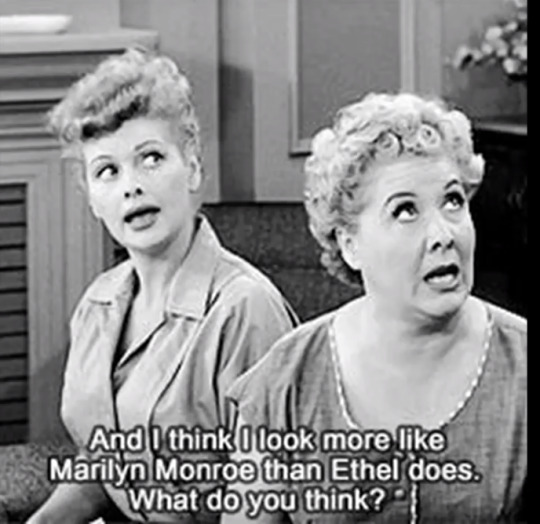
While Lucy has the facial features, Ethel has the blonde hair.

Fred (hilariously) settles the argument!
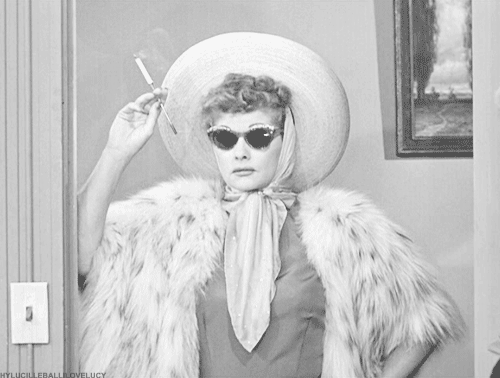
In “Ricky’s Screen Test” (ILL S4;E7) a long list of Hollywood names are dropped in anticipation of hobnobbing with celebrities, including Marilyn Monroe.
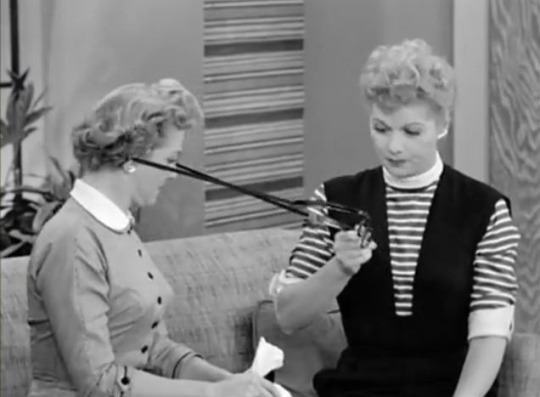
In “Lucy and Harpo Marx” (ILL S4;E28) Lucy wonders if Ethel might pass for Monroe to a near-sighted Carolyn Appleby. After Ethel tries to walk like Marilyn Monroe, Lucy decides that “nobody is that near-sighted!” Fred says that he looks more like Marilyn than either of them!
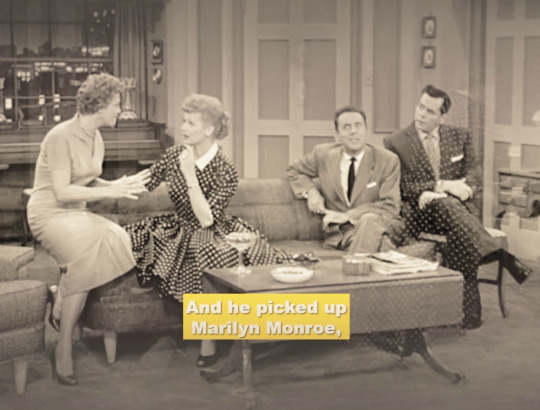
In “Lucy and Superman” (ILL S6;E13), the Appleby’s come over for a social evening that Ethel calls “the bore war” because the couples only talk about their children. As the scene opens, Caroline is in mid-sentence talking about a Marilyn Monroe film.
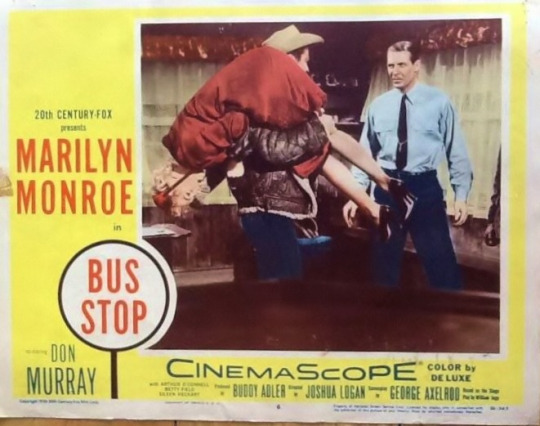
CAROLINE: “...and he picked up Marilyn Monroe, slung her over his shoulder and carried her off!”
Although the title is never mentioned, the film they are discussing is Bus Stop, starring Marilyn Monroe and Don Murray. It was released in August 1956, two and a half months before this episode was filmed.
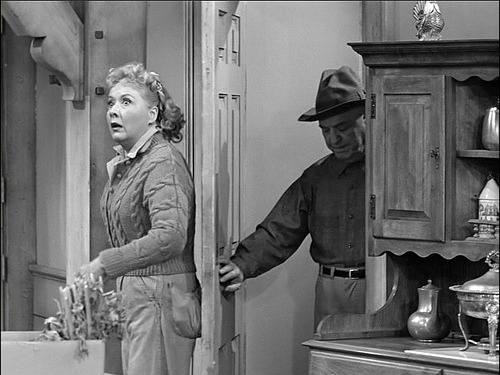
When “Lucy Does the Tango” (ILL S6;E20), she stuffs eggs down her blouse and Ethel stashes a some in her back pockets. Lucy tells her, “Whatever you do don’t try to walk like Marilyn Monroe,” but the ‘yolk’ is on Ethel when Fred suddenly enters through the kitchen door!
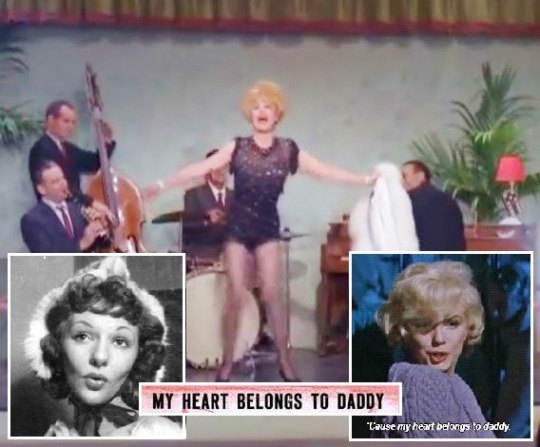
In “Lucy the Gun Moll” (TLS S4;E25), Lucy plays Lucy Carmichael and Rusty Martin. The name Rusty Martin was probably derived from Lucy’s hair color and the surname of Mary Martin, who introduced the song “My Heart Belongs to Daddy” (music and lyrics by Cole Porter) in the 1938 Broadway musical Leave It to Me. Marilyn Monroe sang it in the 1960 film Let’s Make Love. In that same film, Harry Cheshire, who played Sam Johnson in “Oil Wells” (ILL S3;E18), played Monroe’s father. Jerry Hausner (Jerry, Ricky’s Agent) and Joan Banks (Reporter Eleanor Harris in “Fan Magazine Interview”) played uncredited supporting roles.
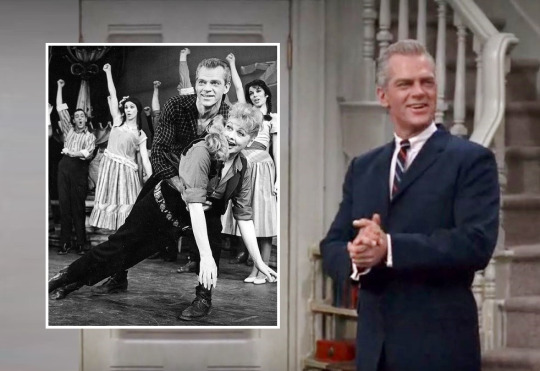
Lucy and Marilyn shared a leading man in handsome Keith Andes. Andes was Lucy’s male lead in Wildcat on Broadway, and later played was featured on three episodes of “The Lucy Show.”
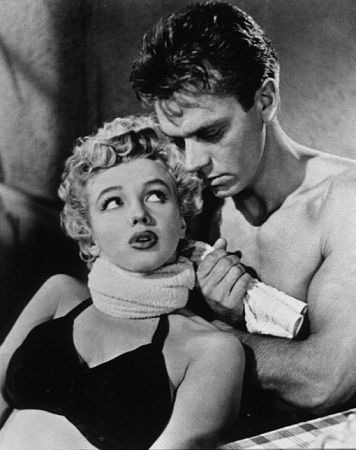
In 1952, he played opposite Marilyn in Clash By Night, an RKO picture.

In “Lucy Gets Ricky on the Radio” (1952), the June 3, 1952 of Look Magazine actually had Lucille Ball and Marilyn Monroe on the cover! Monroe was promoting Clash by Night, and Desi had written a feature on his wife for the magazine. So Marilyn actually did appear on “I Love Lucy” - if only in a still photo.
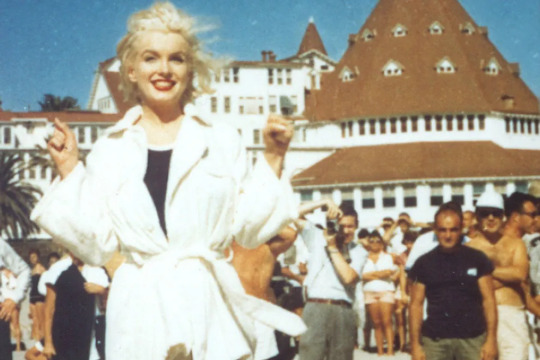

Some Like It Hot (1959) is arguably one of Marilyn Monroe’s most popular films. What does it have in common with Lucille Ball? In 1958, both Lucy and Monroe were depicted at San Diego’s famous Del Coronado Hotel. It is the hotel that the Ricardo’s and Mertzes stay at in “Lucy Goes to Mexico” (LDCH S2;E1) as well as the backdrop for much of the film. Although Desilu filmed establishing footage of the hotel, the cast stayed in Hollywood, while Monroe went on location (as seen above). In “Lucy Goes to a Hollywood Premiere” (TLS S4;E20), Mr. Mooney says he wouldn’t buy a second hand nightie if it had been worn by Jack Lemmon in Some Like It Hot.
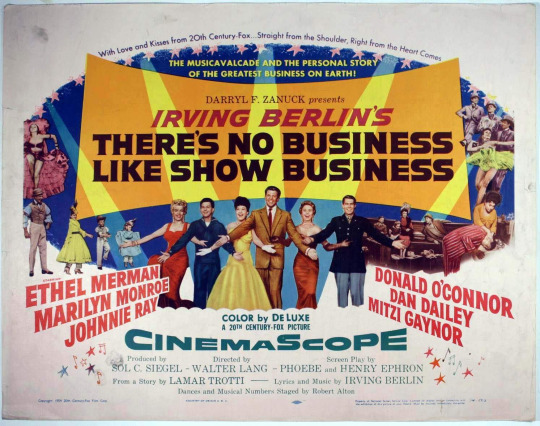
The Irving Berlin song “There’s No Business Like Show Business” was sung on “I Love Lucy” and “The Lucy Show.” Although it was originally from the Broadway musical Annie Get Your Gun (1946), it also served as the title and was performed (by Merman) in the Marilyn Monroe film There’s No Business Like Show Business in 1955.

In 1952, Marilyn co-starred by Richard Widmark (”The Tour” ILL S4;E30) in the film noir drama Don’t Bother To Knock. The film also featured “Lucy” players Lurene Tuttle (Fine Arts League President), Verna Felton (Mrs. Porter), Gloria Blondell (Grace Foster), as well as Harry Bartell, Olan Soule, Robert Foulke, and Bess Flowers.
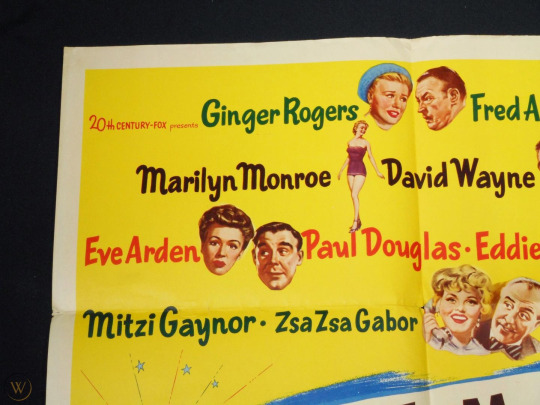
That same year, Monroe starred in We’re Not Married! opposite Lucy’s friend and former co-star Ginger Rogers, as well as Eve Arden (”Hollywood at Last!”), Paul Douglas (”Lucy Wants a Career”) and Eddie Bracken (Too Many Girls).
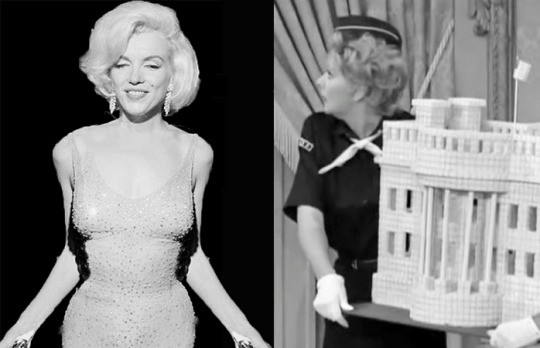
One of Monroe’s most iconic moments came in March 1962 when she sang “Happy Birthday” as a birthday present to President John F. Kennedy in a public birthday celebration also attended by Lucy’s friends and co-stars Jack Benny, Jimmy Durante, Henry Fonda, Danny Kaye, Shirley MacLaine and Elliott Reid. A year later, Lucy Carmichael also gave Kennedy a present, a sugar cube replica of the White House on “The Lucy Show” with Elliott Reid doing Kennedy’s offstage voice as well as playing a small on-camera role!
"I never quite understood it, this sex symbol. I always thought symbols were those things you clash together! That's the trouble, a sex symbol becomes a thing. I just hate to be a thing. But if I'm going to be a symbol of something I'd rather have it sex than some other things they've got symbols of." ~ Marilyn Monroe, 1962
Monroe was married (and divorced) three times:
James Dougherty, Merchant Marine & Policeman (1942-46)
Joe DiMaggio, Baseball Player (1954-55)
Arthur Miller, Playwright (1956-61)

In “Lucy is Enceinte” (ILL S2;E10), Fred gives Lucy a signed baseball for his future 'godson’. When he asks Lucy to read out the signature, she at first says “Spalding,” the ball’s brand name, but then finds it is signed by Joe DiMaggio.

In “Ragtime Band” (ILL S6;E21), Little Ricky asks his Uncle Fred:
LITTLE RICKY: “Who’s Joe 'Maggio?” FRED: “'Who’s Joe 'Maggio?’ You talk more like your father everyday.”
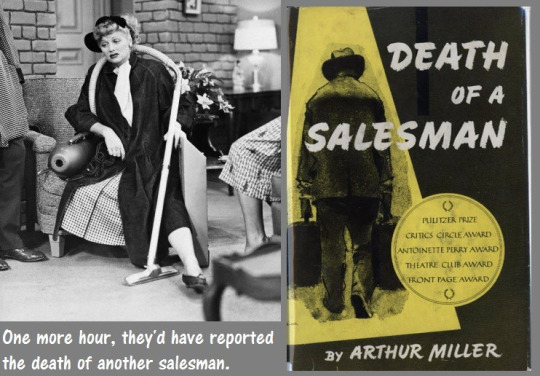
In “Sales Resistance” (ILL S2;E17), Lucy compares herself to Willy Loman, the title character in Death of a Salesman, a Pulitzer Prize-winning play by Arthur Miller first produced on Broadway in 1949 and made into an Oscar-nominated film in 1951.
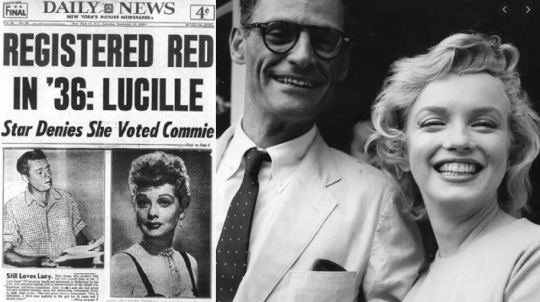
Speaking of husbands, Desi Arnaz has something in common with Marilyn Monroe, too. Both of their souses were accused of being Communists by the House Un-American Activities Committee during the 1950s. Both Lucille and Arthur Miller were cleared of charges and their careers continued, although that was not true for many celebrities of the time.
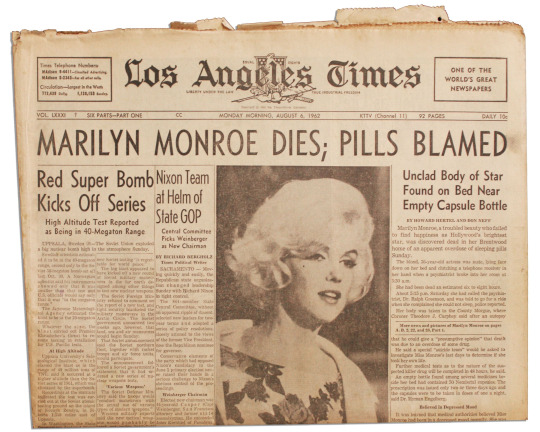
Monroe died on August 4, 1962. The toxicology report showed that the cause of death was acute barbiturate poisoning. Empty medicine bottles were found next to her bed. The possibility that Monroe had accidentally overdosed was ruled out because the dosages found in her body were several times over the lethal limit.
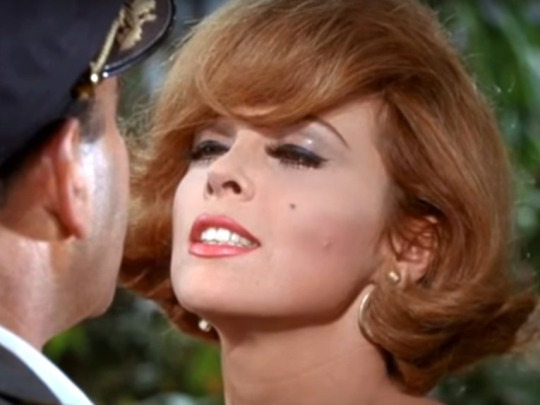
The character of Ginger, the movie star castaway on “Gilligan’s Island” (1964-67) was described during casting as a combination of Lucille Ball and Marilyn Monroe. Tina Louise had Lucy’s red (ginger) hair and Monroe’s shapely physique. The series also featured Natalie Schafer (Phoebe Emerson) as Mrs. Howell, and Alan Hale Jr. as the Skipper. Hale performed on “The Lucy Show” and “Here’s Lucy”. Series creator Sherwood Schwartz was a Lucy fan. His brother Elroy Schwartz actually wrote scripts for Lucille Ball.

In the 2013 web-series “Ryan & Ruby” both Lucille Ball and Marilyn Monroe are given special thanks for their inspiration. The last name of star and creator Ryan Burton's character is "Carmichael", the same as Ball's character on the "The Lucy Show". In Ryan’s kitchen there are fridge magnets with photos of both Lucy and Marilyn.
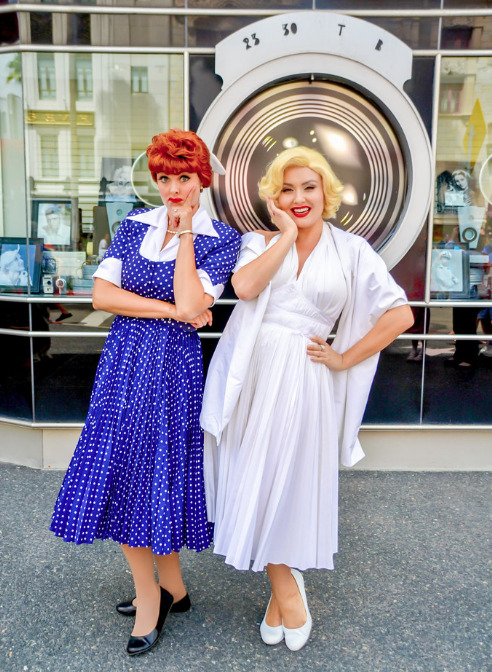
Lucy and Marilyn are street characters at Universal Studios theme parks, their iconic hair and costumes making them instantly recognizable.
The same day Marilyn Monroe was born in 1926, another Hollywood icon with connections to Lucille Ball was also born, Andy Griffith. To read his birthday blog, click here!
#Marilyn Monroe#Lucille Ball#I Love Lucy#William Frawley#Desi Arnaz#vivian vanc#the lucy show#Ryan and Ruby#Gilligan's Island#Tina Louise#Arthur Miller#Joe DiMaggio#Keith Thibodeaux#Alan Hale Jr.#natalie schafer#John F. Kennedy#Paul Douglas#Eve Arden#Ginger Rogers#Verna Felton#Ethel Merman#Richard Widmark#There's No Business Like Show Business#Hotel Del Coronado#Don't Bother To Knock#Some Like It Hot#Look Magazine#Keith Andes#Clash By Night#The Seven Year Itch
50 notes
·
View notes
Note
1. Who do you think is the most historically maligned figure from the Wars of the Roses? 2. What is your favourite 15th century fashion? 3. If there was any other historical period you could learn more about, what would it be?
Anonymously message me (3) things you want to know about me: https://lady-plantagenet.tumblr.com/post/624908501545893888/anonymously-message-me-3-things-you-want-to-know
I see you’ve noticed that I was the anon on yours 😉. Thank you so much for giving me this opportunity to overshare ;)
1. The most maligned figure is hands down *drum roll of predictability* George Plantagenet, Duke of Clarence. Assuming we are speaking of our contemporary opinions, these are the figures which are famously maligned:
Margaret Beaufort, Elizabeth Woodville, George Duke of Clarence, Richard Neville Earl of Warwick and Richard III.
Open any amateur historical fiction novel or popular history work written in our time and you can be sure that at least one of those is a moustache twirling villain. Of course, Richard III now has an entire franchise depicting him as a saint and focal point so maybe he shouldn’t be in the list. Elizabeth Woodville has The White Queen legacy and a bunch of biographies protecting her, some even going so far as to clear her name almost to the point of whitewashing (no Desmond, Thomas Cooke, Lambert Simnel participation etc) her to just a grieving mum.
Now Margaret Beaufort and Warwick also get the short end of the stick. The former gets allocated the blame of the Princes of the Tower and being a scheming, ambitious, religiously fanatical mother-in-law from hell. The latter is depicted as an opportunist man without principle who uses his daughters like livestock (even though they were all he had so it’s bs) and rebels just for the sake of rebelling. Nevertheless, the writers/general public never fail to acknowledge their genius and intelligence. Not to mention, they each have their fair share of biographies which have done much to change public perception of them (e.g. Nicole Tallis and J. Kendall)
Whereas George... Shakespeare made him relatively nice but also quite dumb, whereas all successor fiction go a step further and make him evil and dumb. You know, one wonders how the only man alive to have betrayed and outsmarted both Edward IV and Warwick could possibly have been so dumb. I won’t go in much detail here, but contemporaries such as Crowland Chronicles have noted his ‘talent and an intelligence that rivalled his own brother’s’ and how his legal arguments were a match against his brother Richard’s during the Neville Sisters inheritance dispute. I will no doubt be posting more once I get my hands on the Hicks biography.
Historically, George was quite ruthless, yes, but the following that I have read him do in fiction are just... what: a) Planning on murdering Anne Neville, b) Poisoning Isabel in order to marry Mary of Burgundy, c) Injuring Richard and causing his sclerosis(???), d) beating his wife... shouldn’t there be a libel law against dead people...? Because there really really should be. Not to mention most scholars treat him as utterly inconsequential as if it was not him who by 1478 remained a popular icon and the greatest threat to the crown.
2. My favourite 15th century historical fashion? Ooof you came to the right place!

A lot of them are here in this picture:
1. The Burgundian gown with fur trim will always be a favourite. Cruelty aside, I personally always loved the elegant effect fur has on one’s outfit.
2. The pointy poulines (the shoes) have reached stupendous lengths by the 15th century. They are an example that one does not need heels to be sophisticated. Not to mention they would be harder to walk in than heels (noblepeople of that time were trained from a young age to adopt a certain gait).
3. Conical Henins, the taller and more untenable the better. Like the one in the picture and this:

Honourable mention goes to: The Houppelande, the chaperon, the heart-shaped henin and mens’ hoses. I like how fashion then was more of an art and form of expressing one’s opulence rather than todays’ focus on sexualising womens’ bodies.
3. Another historical period I would like to learn more about would probably be 15th century Wallachia and Moldova. It was a tumultuous time of internal conflict against the wider Ottoman threat. Also, it feels close to me because my ancestors were involved!
Another time would be 19th century Austria-Hungary/German history, as I’ve always found Elisabeth Empress of Austria a fascinating figure and I love learning about the end of eras. In this case it would be the beggining of the end of the Habsburg empire!
An additional time would be the Angevin period in English history, I am particularly interested in Eleanor of Aquitaine, John I and Geoffrey Duke of Brittany and the internal family struggles and loss of French territories!
#🍷❤️#george of clarence#wars of the roses#as you can tell I really enjoyed doing this!#love you for asking me this#thank you#medieval fashion
9 notes
·
View notes
Text
People are not what they seem – Thoughts on episode 7
This episode was a bit of a mixed bag for me. There were moments I loved but overall it left me more than a little frustrated.
Sparks joy
Arthur Parker
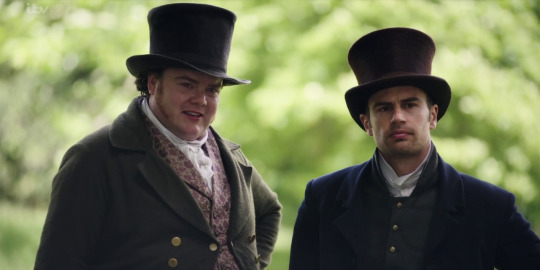
Arthur has always sparked joy for me. His pineapple takedown was one of the most iconic moments of this show and he does not disappoint in episode 7. A lot of people were surprised to see him make the salient points to both Sidney and Georgiana. But I would argue that’s because they haven’t paid attention to Mr. Heywood’s warning back in episode 1.
People are not what they seem in Sanditon and you shouldn’t let what other characters think about one person or another influence your opinion of them. Arthur might be a hypochondriac but, by and large, he has been considerably less trouble to anyone than the likes of Georgiana or Tom. He has also always been, in his own way, incredibly wise and brave. He asked Georgiana to dance when everyone was staring at her in a state of shock and he taught Lady Denham a lesson when even Sidney remained silent.
So it’s no small wonder that the task of reminding Sidney that Eliza Champion might not be the most trustworthy person in the world falls onto him.
It could hardly fall onto Tom … Listen I’ve tried my best to be as understanding with Tom Parker as I could be, making excuses for him left and right. But no more! In this episode alone, he tries to pass off his passive aggressive bullshit onto Mary when she rightly makes him see that hanging around Lady Denham’s drawing room like a carrion crow makes him no better than the likes of Edward Denham. He fallows that up by trying to push his younger brother into a quickie wedding to a woman that abandoned him in favor of a richer husband and sent him on a self-destructive path that almost killed him. What a bozo!!!
At the very least, as his older brother, it was up to Tom to advise Sidney to be a little careful in restarting his relationship with Eliza. But no, that task falls unto Arthur because Tom can’t be trusted with anything more challenging than miniature house building.
Esther and Lord Babington

Speaking of people not being what they seem, these two are by far the biggest surprises Sanditon has to offer. Esther started off as a combination of Mary Crawford and Caroline Bingley and she’s turned into freaking Ingrid Bergman in Gaslight over here!
Don’t ever let anyone tell you Sanditon is just a shallow bodice ripper because the way it went about effortlessly depicting a woman struggling through an emotionally abusive relationship with a narcissist is masterful! And her setting herself free of Edward in this episode was glorious!
As was Lord Babington proving to be a better Darcy than Darcy himself. His deep empathy for her, his complete rejection of Edward’s bitter gossip mongering and his unconditional support was truly moving. Bless him and his orange handkerchief!
PS: Give this man a first name, Davies! He’s earned it!
The Heraclitus of it all
Again, I firmly believe that the people who are dismissing this show as just a spot of shallow entertainment, aren’t really paying attention because the whole scene of Charlotte’s assumed humiliation is so carefully and masterfully built it’s delightful to watch
Charlotte takes Sidney’s “I’m certain Charlotte would prefer to be reading Heraclitus” line as an insult that depicts her a country bumpkin who is not fit for the fashionable London crowd.
But should she? We already know that Sidney reads Heraclituss himself. They were just bonding over that on their little boat ride. And look where his line comes into play:
Eliza: There must be a boy in your village that’s caught your eye.
Lady Susan: Why should Charlotte be limited to her village?
Eliza: I always think it helps to share a common background, that’s all. Miss Heywood is hardly likely to find a kindred spirit in this company.
Lady Susan: Why not?
Eliza: I just imagine she must find our London talk unspeakably tedious. Wouldn’t you agree, Sidney?
Sidney: I have no doubt Charlotte would rather be sat somewhere, quietly reading Heraclitus.
What Sidney is actually saying is that there is someone there who is a kindred spirit to Charlotte: HIM! He isn’t insulting her or laughing at her. He’s making a call back to their London ball scene where they both felt out of place but found solace in each other. What he’s telling her is that he doesn’t belong amongst Eliza’s crowd either.
This kind of subtle, clever writing is actually a lot rarer than you might think and, for me, drives to the core of why Andrew Davies is such a fantastic writer. He not only understands how to present a period drama to a modern audience in a way that is fresh and interesting but also how to create these moments of brilliant writing complexity almost effortlessly.
Georgiana Lambe
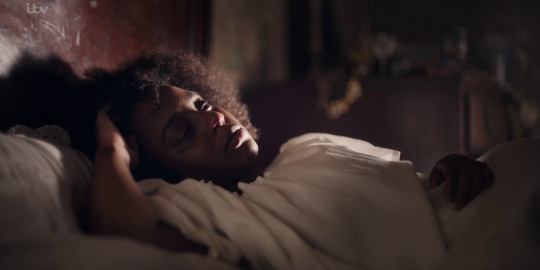
Georgiana, the character, isn’t really sparking joy for me as she’s behaving like an utter brat but the writing for her character is. She’s been terribly hurt for the first time in her life so she’s lashing out anyway she can. Also this line is brilliant:
Sidney: I am all too aware that I have fallen short as your guardian. But please believe that I am sincere in my desire to make amends.
Georgiana: Men like you cannot change.
Why is that brilliant? Well because Georgiana is engaging in one of the oldest and most popular forms of toxic anger: transference. What she’s really saying is that Otis will never change enough for them to be together. But Otis isn’t there, Sidney is so he gets to be the punching bag du jour.
The reason why depicting her grief in this way is so compelling is because it’s so natural to her story. She was already feeling like an outcast in England, not loved or wanted by anyone. Otis let her concentrate all of her self-worth entirely on him (one of the worst things he did and not the only one but that’s a subject for another meta) and then failed to live up to his inherent promises. Georgiana feels that no one cares for her and so she pushes the people who are trying to help her away so she can have her very own self-fulfilling prophecy.
And while her interaction with Sidney might be somewhat understandable considering his cold attitude towards her in the beginning and also the fact that whether or not Georgiana likes it, he’s the closest she has to an actual parental figure, her attitude towards Arthur absolutely is not.
Her insults, thankfully, fall on deaf ears because Arthur knows he is a precious lily of the field and we are all very happy he’s here!
Does not spark joy
Sidney and Eliza
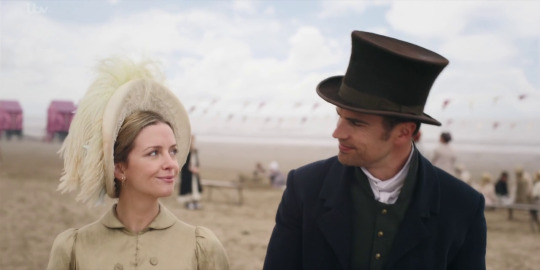
From what I see in the tags, no one is really all that fond of Eliza … I wonder why … lol …
But protectiveness over my ship isn’t really why this storyline didn’t spark joy for me. It’s actually because it failed to live up to its potential. The writers chose to make Sidney and Eliza’s reunion all about how that affects Charlotte and dedicated very little time to the Sidney/Eliza dynamic.
And it started so well too. I had high hopes when Sidney said this:
Sidney: A man cannot step into the same river twice.
What Sidney is talking about in very poetic terms if what in my country we call “reheated soup”. That’s what Eliza is … a chance to reheat the soup. Except that the saying goes: reheated soup never tastes the same which is absolutely true when it comes to relationships. Tempting as it might be to rekindle something, it very rarely works out because the reasons why you broke up in the first place will eventually rear their ugly heads again. Which they do in their case as well, when Eliza needlessly attacks Charlotte, proving herself petty and superficial.
But because we never stay with Sidney enough to figure out what his attraction to her might have been once upon a time, because we don’t get to see how reuniting with her is stirring not only his feelings of long lost longing but also of the trauma she caused and because we don’t even get to watch their last conversation together, it all fails to make the impact that it could have made. Which is a shame …
IMDB has Ruth Kearney listed for episode 8 as well and a part of me hopes Eliza will be back next week and we can have a bit of a do over.
Lady Susan
I know everyone likes her and the actress is delightful. However as much as I might enjoy her in isolation, within the context of the story she remains a poorly introduced character who is only on screen to push Charlotte and Sidney together (we never find out why she’s so invested in this) and to act as a deus ex machine for the regatta.
The ��half agony, half hope” that is …
Charlotte
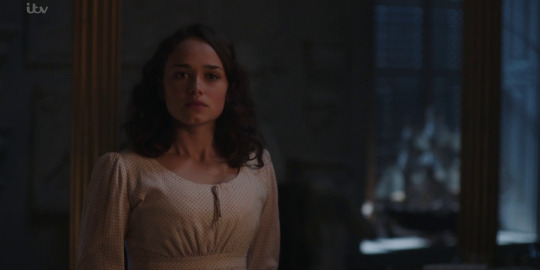
I really hate to do this because I love her but most of my frustration this episode came down to Charlotte.
Her behavior was confusing, dissatisfying and at times quite thoughtlessly cruel. Most of that was directed at poor James Stringer.
As you know, I am a Charlotte/Sidney shipper so I don’t have a problem with Charlotte not returning James’ affection. In fact I’ve made the point in the past that the whole Tem Stringer vs. Team Sidney promotion was silly because it was clear there was no rivalry there.
However, Charlotte behaves very poorly to him in this episode. It’s the second time now (the first was in episode 4) where she’s used James as a stand-in for Sidney. Every time she’s talking to this boy, her mind is miles away and she ends up missing all the signs that she’s stringing him along (no pun intended but the clue is in the name, I suppose).
What Charlotte really wants is for Sidney to give her the same undivided adoring validation Stringer gives her and because he isn’t, she ends up engaging with James in a way that is less than ideal. That’s not so say she necessarily realizes she’s doing this but her thoughtlessness is starting to be frustrating.
Which brings me to … her behavior towards Sidney. The way unrequited love seems to work for Charlotte is that it makes her less than generous and she looks for any opportunity to cut Sidney loose, so to speak.
She doesn’t attempt to put up a fight for him at any level, despite this being the girl that fights for everything that matters to her. And it all comes crushing down during the conversation with Eliza, when she takes the smallest opportunity to completely shut him out.
It’s also kind of hypocritical of her to still be angry at this comment at the end of the episode, when she did far worse. I mean if you want to talk about someone being someone else’s “source of amusement” look no further than:
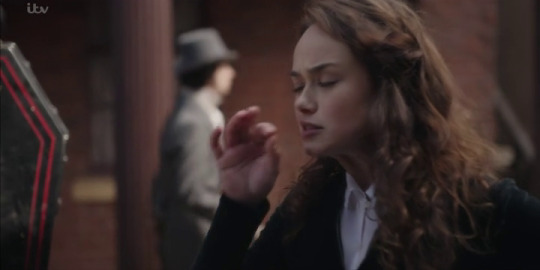
Charlotte (imitating Sidney): You see, Georgiana, this is exactly why I locked you away in Mrs. Griffths’ dungeon. To keep you out of mischief, while I, Sidney Parker, gallivant around London with my high society, dandy friends.
So while deciding that Sidney was an ass to her is tempting, I’d like to point out that, as I’ve shown earlier, there is nothing mean spirited or negative in his comment at all. So is it fair to say that Sidney hurt her when the most obvious explanation is that Charlotte is insecure? She has been since the moment she met Sidney and Eliza instinctively preyed on that insecurity. And Charlotte not only let’s Eliza hurt her but she also transfers her insecurity firmly onto Sidney’s shoulders, instead of owning it or resolving it.
The reason why this is in the half agony, half hope category is because I’m not sure if the above is the writers’ intention or if I’m trying to make this more interesting than it actually is. If their intention is to paint Charlotte as completely right about everything, while Sidney is the fool who needs to repent and Stringer is the guy who got ahead of himself, I’m going to be pretty disappointed.
For the moment, we’ll have to wait and see, I guess.
#sanditon#sanditon 2019#my meta#charlotte heywood#sidney parker#young stringer#arthur paker#georgiana lambe#eliza champion#charlotte x sidney#sidney x charlotte
89 notes
·
View notes
Text
D-Views: Muppet Treasure Island
Hi, everyone! Welcome to another installment of D-Views, my on-going written review series for films that fall under the Disney umbrella, as well as those that were influenced by those films! For more reviews for movies like Mary Poppins, Treasure Planet, and The Prince of Egypt, please consult my “Disney Reviews” tag and, of course, if you enjoy this review or any of the others, please consider liking and reblogging!
Today’s film is one of my childhood favorites, starring a cast of some of my favorite people, as well as frogs, pigs, and even whatevers. This is Muppet Treasure Island! (Thank you for your votes, @the-alexandrian-alchemist, @silvvergears, @extremelybears, @livinlifelikeishould and @karalora!)

Ever since 1976, the characters of the Muppet Show have been American pop culture icons. The show itself won a total of 21 Emmy nominations and four television awards over its long run, and by 1990 its cast had also starred in several critically acclaimed films (The Muppet Movie, The Great Muppet Caper, and The Muppets Take Manhattan) and the very popular animated TV show Muppet Babies. And all of that wouldn’t have been possible without the Muppets’ creator, Jim Henson.

Like at the Walt Disney Company, the loss of their leader in 1990 hit Jim Henson Productions very hard. One silver lining, however, is that just like with Walt Disney, Jim Henson was memorialized not just by the characters he created, but by his many achievements and the many friendships he’d made in life. He received a Star on the Hollywood Walk of Fame alongside Kermit the Frog; was inducted into the Television Hall of Fame; earned a memorial in his hometown Hyattsville, Maryland; was posthumously named a Disney Legend; was the focus of the heartfelt TV special The Muppets Celebrate Jim Henson; and was laid to rest with two formal funeral services complete with performances of some of his favorite songs. And just like the Walt Disney Company, even after the death of someone who meant so much to them, Jim Henson Productions got back up and promised to do more in the memory of their lost leader. Jim’s son Brian Henson took the reins and directed the Disney-co-produced Christmas movie The Muppet Christmas Carol in 1992, before he moved on to their next project and today’s subject, Muppet Treasure Island.
So, here’s the thing -- I have a LOT of nostalgia for this movie. I will be upfront about that. But even with that acknowledged, I was sort of stunned when I found out how lukewarm the reaction to this movie was, when it was released in theaters. Sure, I knew it hadn’t broken the bank, but even if it earned about $34 million worldwide, it received no honors or awards, only hit third at the box office opening weekend behind the movies Broken Arrow and Happy Gilmore, and even now only boasts an average 73% rating at Rotten Tomatoes. Critics at the time criticized how it was more “Treasure Island” than “Muppet”, with Roger Ebert calling it “less cleverly written” and Gene Siskel even more coldly deeming it “boring.” Although I’ll readily acknowledge that reading those reactions makes me want to run outside and scream “FUCK YOU, GENE SISKEL” at the top of my lungs, I promise to give a more rational review of this movie instead, one hopefully that acknowledges any possible shortcomings, but also will celebrate this film and how completely NOT boring it is.

One of the best things about this movie hits us in the face right off the bat -- the music, written by scoring giant Hans Zimmer and Nick Glennie-Smith. As much as I enjoy a lot of Muppet musicals, I attest that Muppet Treasure Island has the most cohesive score overall of any Muppet production. The Muppets were always creatures of the short, sweet vignette -- of the variety show -- of many disparate pieces sewn loosely together into a whole like a patchwork quilt. Even though The Muppet Christmas Carol’s soundtrack comes very close in its cohesion and I would say The Muppets (2011) -- my personal favorite Muppet movie -- is truer to the spirit of the Muppet Show in its music while also paying tribute to old-fashioned movie musicals, Muppet Treasure Island just paints a full-bodied picture from the off-set, building on refrains that return and morph over the course of the picture. From the very beginning, we get that this venture is NOT a standard Muppet movie. Like The Muppet Christmas Carol, the Muppets’ humor will only be part of the story told -- in TMCC, it takes a backseat to sincere emotions like love and redemption, while here in MTI, it takes a backseat to adventure and swashbuckling action.
The score also seamlessly flows into our first song, “Shiver My Timbers,” which just screams “pirate!” I’ve loved pirates ever since I was a little kid, and Muppet Treasure Island was one of the main reasons why. I was okay with Peter Pan, but Muppet Treasure Island was what really got me excited about pirates. They were rough, ruthless, and dangerous, but it was exciting to face off against them in an epic musical adventure, even if your only weapons were a couple of artfully thrown starfish. In the 90′s, pirate films weren’t really “in” -- it wouldn’t be until 2003 with the release of Pirates of the Caribbean that they became popular again -- but I think Muppet Treasure Island, through its music, really embraces the fun, action-packed thrills that Disney would later capitalize on in the Pirates films.
After our prologue, we meet Billy Bones (played by the perfectly cast Billy Connolly) and, of course, our hero, Jim Hawkins, played by newcomer Kevin Bishop. Kevin was the very first of a hundred kids who showed up for the audition to meet the casting agents, and he was selected for the part then and there. Sadly post-Muppets he moved on to stage and television, but for what it’s worth, I quite like Kevin in the role of Jim. He’s distinctly depicted as a boy, complete with a pre-puberty “boy soprano” singing voice (which I acknowledge is an acquired taste, but I personally enjoy), but that characterization only serves to accent how large of an arc he goes through over the course of the film. He starts off as smart, sincere, honest, and dreamy, but also very innocent and trusting, and over the course of the story, he learns to ground himself in who he is and what he believes in, to the point where he has to sever ties with someone he once considered a friend and mentor. Accompanying Jim in his journey are Gonzo and Rizzo, who largely serve as comic relief but do still serve as good friends and companions to Jim, as evident by the three characters’ “I Want” song, “Something Better.” Yes, Gonzo and Rizzo are sidekicks, but they’re still distinct personalities that bounce well off each other and “straight-man” Jim. Originally the filmmakers had considered simply having Gonzo and Rizzo being two characters called “Jim” and “Hawkins” respectively (splitting the part in two, not unlike what they did with Statler and Waldorf in The Muppet Christmas Carol), but due to concerns that the choice would result in a lack of heart in the finished product, that idea was scrapped. I think it ultimately was the better decision to leave the drama to the humans -- it’s not that the Muppets can’t conjure sincere emotion (just look at “Pictures in my Head” or “Man or Muppet”), but I still think having any of the existing Muppets fulfill the “coming of age” narrative the original Jim Hawkins goes through would’ve been a bit of a stretch. Even in The Muppet Christmas Carol or non-Muppet-show Jim Henson production Labyrinth, the main characters with a story arc are played by human actors who are able to ground the picture despite the cast of colorful, irreverent characters.
One of the main criticisms that critics of the time lobbed at this movie is that it feels more “Treasure Island” than “Muppet”, and in a way it’s a decent point, if not phrased very badly. Unlike in other Muppet projects, the humor plays second fiddle to the plot and the characters are not the characters we know from the Muppet Show with their Muppet Show backstories and consciousness. In The Muppet Christmas Carol, the film could very easily be seen as a “production” being put on by the Muppets, even if it’s never overtly stated as such, thanks to Gonzo (as Charles Dickens) constantly breaking the fourth wall. In Muppet Treasure Island, however, Gonzo and Rizzo have their own non-Muppet-show history as friends of Jim Hawkins way before ever meeting the other Muppets like Kermit and Sam the Eagle, and Kermit and Miss Piggy have a whole soap-opera romance that involves a wedding and getting marooned by pirates (we’ll get to that later). So yes, this is more “Treasure Island,” but it’s not less “Muppet” -- it’s less “Muppet Show.” These Muppets have different histories, but they’re the same characters despite this. Gonzo is an eccentric thrill-seeker -- Rizzo is a cowardly cynic -- Kermit is a soft-spoken pacifist -- Fozzie is a lovable dimwit -- Piggy is a self-centered diva. Think of Muppet Treasure Island as a Muppet AU fanfiction -- these may not be exactly the characters you know, and yet...they are! They’re the exact same big personalities with the same quirks, strengths, and weaknesses, just in an alternate universe. And honestly, I think it’s really cool, to see these sorts of characters so exclusively used for comedy in a world that’s not flat-out comedic -- one that’s kind of dirty and rough around the edges, with swashbuckling action and real danger around every corner.
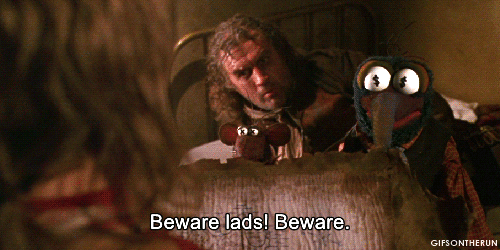
The nice thing is that although yes, the comedy isn’t the central focus anymore, there is still really good humor in this film, a lot of it thanks to the shift in tone. There’s just something so very, very funny to me about Billy Bones’s death scene being followed up by Rizzo, Gonzo, and Jim just flat-out freaking out and dashing out of the room screaming like stupid kids, or the tense action scene where the pirates storm into the inn being punctuated by Rizzo trying to help Gonzo load the gun, only to spill the bag of bullets, or the epic entrance of the illustrious Captain Smollett’s carriage ending with the tall, solemn coachman stepping aside to reveal the Captain himself, played by Kermit the Frog. I think it plays into the ideas of subverting expectations and building up a punchline properly before delivering the joke -- as each scene is built up, we’re left constantly unsure if the film’s going to play things straight or just be completely irreverent, and the contrast is what can make a joke much funnier than in a purely, solely humorous scenario. There are a few points where the contrast can become a bit labored, but I laugh so much more during this movie that I ever have watching my favorite reruns of the Muppet Show, no matter how much I enjoy them. It’s something that, again, the Pirates of the Caribbean films would capitalize on much later. (Too bad they couldn’t incorporate that humor into any catchy musical numbers! Disney, where’s my Pirates of the Caribbean musical?)

Aha, and now we come to the brightest of the shining stars in this film -- our villain, Long John Silver, played by the amazing Tim Curry. I’m sorry, it’s an incontrovertible truth that Curry is a unique, magical ingredient that, when added to any movie, just elevates the cinematic dish to a whole new level and leaves you drooling for one more scene with him. I remember someone once saying that Curry is sort of like a Muppet in human skin thanks to his outrageous, yet likable acting, and...yeah, it makes it so that he fits perfectly in this movie, where he has to interact so closely with the Muppets. The nice thing is, though, that he also has a lot of chemistry with his human co-star Kevin Bishop, to the extent that you sincerely feel for the relationship that forms between Jim and Silver even if you know Silver’s intentions from the start. I particularly like their exchange in the ridiculously catchy “Sailing for Adventure,” as well as their scene at the front of the ship where they discuss their fathers and the stars.

Just as the adventure is getting going, however, it stops dead with the wind’s abandonment of the Hispaniola. Out of nowhere, the ship breaks out into the most ridiculous, most “Muppet” of all of the musical numbers, “Cabin Fever.” The song was one of my favorite parts when I was little and it’s always made me laugh, but it’s definitely the biggest detour of the movie that up until that point lived in its own pirate-centric world. It’s a very short-lived detour and as I said, it’s ridiculously funny, but it doesn’t have any bearing on the plot and I could see how people might find it kind of pointless, particularly since it doesn’t even feature three of our main characters, Jim, Silver, or Smollett. One other critique I will give the film is that some of the effects nowadays don’t look very real, like the Hispaniola being composited over still matte paintings -- there are points where the production values remind me a bit of the old Wishbone TV series, where they have to angle the shot just so or get creative just to try to make the ship look as big as it should be. But honestly, there were points where Wishbone impressed me with those same sorts of layering and green-screen effects despite its limited budget, and those cheaper effects don’t look tacky or out-of-place, so I personally don’t mind them that much.

Because this is a Muppet movie, it’s unsurprising that our Mr. Arrow (played by Sam the Eagle) isn’t really killed, instead just being tricked off of the ship by a manipulative Silver, but it says something that, even with that softened plot turn, the stakes are not completely dismantled. We still see the pirates as a legitimate threat when they kidnap Jim and take over the Hispaniola, even when they burst into song. Tim Curry’s “only number,” “A Professional Pirate,” is a perfect expression of his expert, charming showmanship, which in my mind truly can’t be matched by any other performer in Hollywood, past or present. No one gives a performance like Tim Curry. It makes it so that even when I was a bratty kid getting irritated about Silver calling privateer Sir Francis Drake a pirate and using “buccaneer” as a synonym for “pirate,” I would sing this song at the top of my lungs, trying to even reach 75% of the energy Curry put into his vocals.
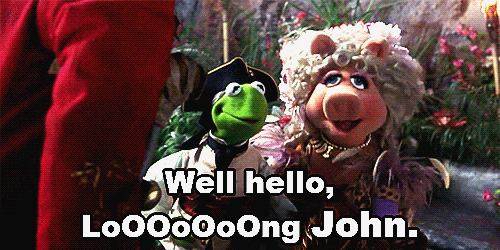
At long last, Miss Piggy makes her grand debut as “Queen Boom Sha-Kal-a-Kal,” a.k.a. Benjamina Gunn. Although the diva doesn’t end up getting much screentime, she certainly gets a grand entrance, complete with an elephant steed decorated with flowers and a full musical number complete with a tribal chant and ethereal vocalizing. And true to form, when she lays eyes on her one true love, Kermit...she smacks him so hard that he’s thrown backwards off his feet and into a gong. What’s particularly interesting about Piggy in this movie is that although she and Fozzie are voiced by Frank Oz as always, both she and Fozzie were actually puppeted by Kevin Clash, as Oz was unavailable during this film’s production, and Oz’s vocals for both characters were added in post-production. Despite the difference in puppeteer, however, both characters are just as likable as ever -- I’d honestly had no clue that they weren’t performed by the same person! The film even got to use the full-bodied remote-controlled puppets for Kermit and Piggy for the love duet “Love Led Us Here,” which is kicked off by an Evita joke I never got as a kid but as an adult makes me grin like a friggin’ idiot. Fortunately the duet is inter-cut with Silver and the pirates finding the treasure, rather than it being chock-full of romantic flashbacks or prolonged looks between the two lovebirds, giving it a lighter tone than it would’ve had otherwise.
With a much reduced crew comprised only of Rizzo, Gonzo, Squire Trelawney, Dr. Honeydew, Beaker, and the newly returned Mr. Arrow, Jim comes to Benjamina and Smollett’s rescue and returns to Treasure Island to face Silver and the pirates. The action scene is full of humor, but because of the world established in the rest of the film, I would argue it still has stakes. The blows still hurt and there’s still a threat of defeat and danger, most notably when Long John Silver prepares to fight. Even if you don’t think the Muppets are going to die persay, you still feel the suspense in wanting to see what’s going to happen next. And when Silver surrenders, he himself can see the real treasure Jim found on his adventure -- a family...a group of people Muppets who will support him and encourage the very best in him.

Silver’s escape scene is a beautifully heart-wrenching scene -- one that could only have been earned by two excellent performances over the course of the film by Kevin Bishop and Tim Curry. Even though both Silver and Jim know that they’re different people and they could never walk the same path, it doesn’t mean that they don’t still greatly esteem and care about each other. In Jim’s case, it’s especially difficult, given that in parting ways with Silver, he has to cut loose of a very poor potential father figure who would’ve only dragged him down in the long run, but who was so likable in his own damaged way. It proves to be a very bittersweet scene sprinkled into a very happy, cheerful ending, complete with the chipper island-inspired end credits bop “Love Power.”
Muppet Treasure Island is -- in my opinion, at least -- one of the best Muppet movies ever made. It broke away from quite a few Muppet conventions, like the characters breaking the fourth wall and being aware of themselves being in a movie or TV show, and embraced a much less humorous tone in both its writing and cinematography. Yes, it reimagined a classic book like The Muppet Christmas Carol did, but this movie took the next step, embracing the world of the original novel as well as the set-up and immersing the Muppets’ cast of characters in it. Although I can see why some people would be more partial to the original Muppet movie formula and love it a lot myself, I really, really respect Brian Henson and the rest of this film’s crew for taking the Muppets in such a different direction. It was an entertaining, action-packed, funny pirate movie before those sorts of movies became popular again, and it remains my favorite “pirate” movie of all time, as well as my personal favorite incarnation of the Treasure Island story (barely beating out Treasure Planet). I know childhood nostalgia can play a role in what media can give you joy as an adult, but I truly don’t think it’s the only factor here -- it’s also just a really good movie, and I can only hope that more people will consider giving it a chance and have just as much fun Sailing for Adventure as I did!
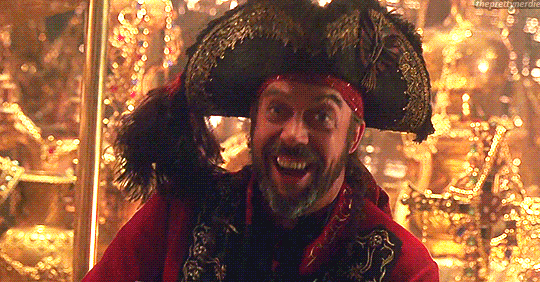
#d-views#disney reviews#muppet treasure island#the muppets#reviews#opinion#analysis#oh boy here i go#brian henson#tim curry#kevin bishop#billy connolly
30 notes
·
View notes
Text
Joan of Arc
Who: Jehanne Darc (often modernized as Jeanne d'Arc) (Joan of Arc is the Anglicization of her name)
What: Soldier and Saint
Where: French, active in France
When: c. 1412 - May 30, 1431
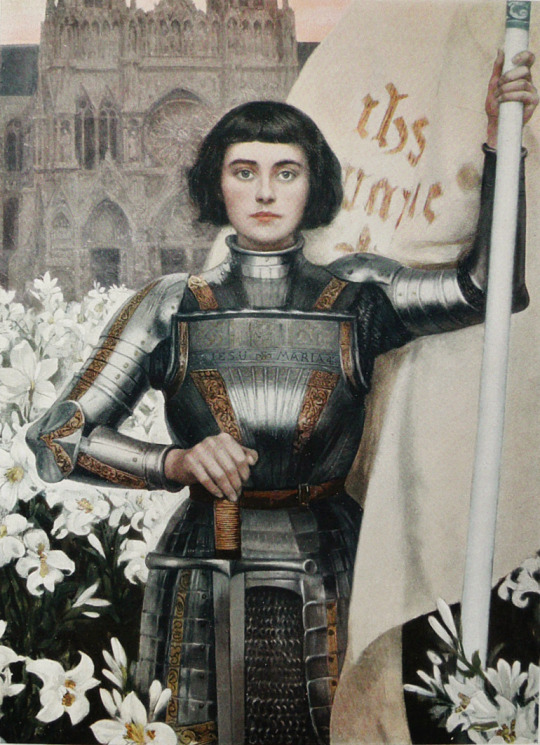
(Image Description: an engraving of Joan of Arc from 1903 by Peruvian artist Albert Lynch. It was featured in Figaro Illustre. It looks more like a painting than an engraving. It shows Joan in the center. In the background is Notre Dame. In the mid and foreground is a field of white flowers. Joan is front and center from the thighs up. She is in full plate mail but without the helmet or gloves. The armor has gold accents. She has pale skin and a round face. Her hair is black and cut into a bob with high bangs. One hand holds a flag and one hand rests on the hilt of a huge sword. She looks stoically and proudly out at the viewer. End ID.)
Joan of Arc is more legend than woman at this point, but she was very real. She is in part responsible for turning the tide of the Hundred Years War in France's favor. Now she is both French cultural heroine and canonized Catholic saint. Joan is an icon and inspiration and to millions be they French, Christian, woman, queer, or all of the above.
Joan's story is fairly well known. She was an illiterate peasant girl who, when she was 13, was visited by the visions of several saints. From that point forward she claimed to have been following God's instructions. At the time, France and England were still locked in the heat of the Hundred Years War (1337-1453) and the English occupied swaths of France. Eventually God told Joan to topple the English occupation and save France. She convinced the Dauphin to give her command over troops and dressed in men's armor Joan lead French victory after victory.
Although there were understandably doubts about what this untrained teenager could actually do she was able to convince naysayers quickly. She won first success at the Siege of Orléans. After the city was sieged for more than six months, Joan was able to turn away the English in only nine days. She was involved in more than a half dozen battles, many victories, between 1429 and 1431. These included the French success at the Battle of Patay and the March to Reims. During the latter she helped siege and reclaim several French cities and ensured the coronation of King Charles VII, at which she was in attendance.
She continued her campaign despite being injured in the Siege of Paris and was ultimately captured during the Siege of Compiègne. Her troops were outnumbered and her attempted surprise attack was rebuffed by English reinforcements, at which point she was overwhelmed and pulled from her horse.
She was captured, tried for witchcraft (although crossdressing was listed among her crimes/charges), and ultimately, horrifically, burned at the stake. Because she was so well loved the English made sure her body was very publicly destroyed both to avoid rumors of her escape and to make sure no relics could be made from her remains (as was very common for holy people at the time). Although English propaganda and court proceedings claimed Joan was a witch who spoke not to God and saints but to the Devil, her executioner still "greatly feared to be damned.". She was only 19 at the time of her death.
Joan has become a larger-than-life figure. Her story has been told and retold countless times over the centuries. Movies, books, plays, operas, songs, pieces of visual art. Nearly every medium that exists has depicted Joan of Arc in some capacity. For example, the first celluloid movie camera was invented in 1895, the first filmed depiction of Joan of Arc was made in only 1898. Mark Twain was very proud of his oft forgotten novel Personal Recollections of Joan of Arc. Voltaire wrote the poem "La Pucelle d’Orléans" (link goes to English translation) and there was a dramatic rebuttal by Die Jungfrau von Orleans (German) by Friedrich Schiller. Tchaikovsky wrote an opera The Maid of Orléans. George Bernard Shaw's Saint Joan is perhaps his magnum opus. Robert Southey and Samuel Taylor Coleridge wrote the epic "Joan of Arc". She is included in Shakespeare's Henry VI Part 1. The likes of Peter Paul Rubins, Paul Gauguin, John Everett Millais, Jean Auguste Dominique Ingres, among others have rendered Joan. She has been used for awards and propaganda.
Joan of Arc even impacted real life fashion, the Bob hairstyle's inventor based the now iconic look off Joan's haircut. It makes sense since the Bob was originally associated with the rebellious women of the 1920s. In 1920 she was canonized and is now the patron saint of France, soldiers, women in the WAVES and WAC, prisoners, among many others.
There is now speculation that Joan of Arc may have been mentally ill or had epilepsy.
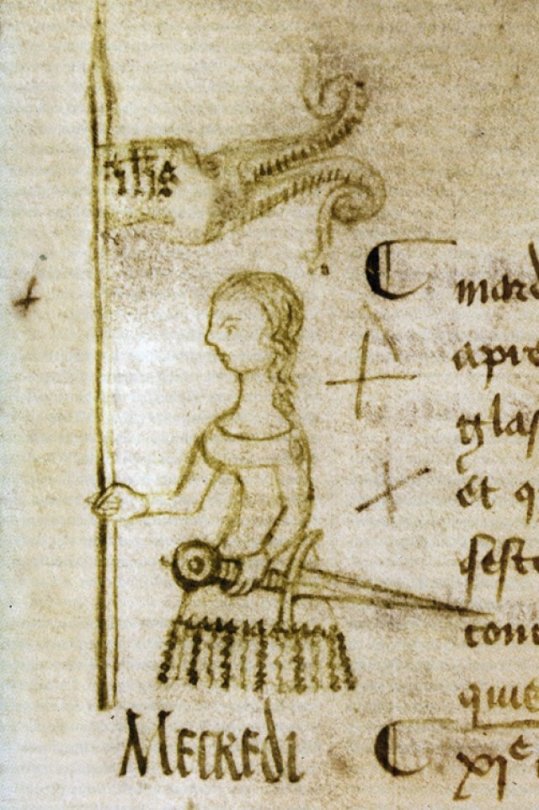
(Image Description: a drawing of Joan of Arc by Clément de Fauquembergue found in the margins of a parliamentary document from 1429. That makes this the earliest drawing of Joan we have. It is a brown ink drawing, slightly crude, very simple, of a woman drawn in profile. It ends just below her midsection. She wears a dress and carries as sword in one hand and a banner in the other. She is scowling. Oddly she does not have the short haircut that would become her trademark look, then again I have no idea how true/untrue to life this is. End ID)
Probable Orientation: Aroace (and obviously GNC. Crossdressing was one of the many crimes for which the English tried her.)
This is already a very long entry because of Joan of Arc's extensive legacy but it is going to get even longer, because I mentioned in Mary Eliza Mahoney's entry that there was another figure I was struggling with in my speculation, here she is. My biggest issue here was more moral than anything else.
Joan was only 19 when she died, that is hardly a full life to determine what her sexual orientation was. I do not object to a teenager self-identifying as any gender/sexual orientation, but it is quite another matter to impose one on them, especially when they died before being able to live a full life.
I thought a lot about the discourse presently surrounding Anne Frank. On my personal blog I have made my opinion abundantly clear (she is not your Bicon, she is a victim of a horrific genocide). So why is Joan different to me? I did some deep soul searching on this. So before going into my evidence as to why Joan of Arc may have been aroace.
The circumstances of their deaths are different. Anne was killed because of her ethnoreligious background in a campaign to wipe out the Jewish people. Joan was brutally killed for her gender and wearing men's clothing as much as she was for being an enemy general. Indeed, she would not have been burned alive had she been a young man doing exactly what Joan did and not a young woman. But her death is not representative of a larger narrative. There were no other Joans of Arc.
Yes, she is now a Catholic Saint, but unlike Anne Frank Joan was not killed for being Catholic and was killed by other Catholics. Also I should add Judaism is much larger than just a religion. It is an ethnicity as well. Joan was the same ethnicity (if not the same nationality) as her captors.
Anne was also a 20th century girl and 15 when she met her horrible demise. Joan's era and age are something I will expand on.
And importantly I am not the first person to ascribe queerness to Joan's story. She has been a queer figure for the better part of a century by now. Some scholars argue she was a lesbian*. Others say she was nonbinary**. Joan has long been important to the queer community, but that wouldn't necessarily make me right for adding to the debate.
But for Joan of Arc queerness is baked right in to the narrative. She wore men's clothing and broke gender norms, actions so taboo they were part of what cost her her life. Whether or not this crossdressing had anything to do with her gender or sexual orientation or just done for ease in battle is a subject of debate and boy howdy there is a lot of it. Plus, the actual act of going to war as a woman was an act of gender nonconformity.
Anyway now I am going to tell you why I believe Joan of Arc was an aroace, because it is another piece of the queerness of her narrative that she touted.
Here is one of the most important pieces of evidence to me, her name. Joan's birth name was Jehanne Darc (or a similar spelling), that was her father's surname and it was technically hers. In life she didn't use it. She called herself Jehanne la Pucelle (Joan the Maid) as in Joan the Virgin. That was the name she rallied her troops under. That was how her (dictated) letters were often signed. I have seen the argument made that she was asserting her purity, but it also would remind her troops of her age. Just like today "virgin" held a connotation of childishness. You were not married and inexperienced. Why would a military general want to point out how young she was? She had another name, she could have just been Jehanne Darc. It also told everyone she was a woman, including the enemy, who might use that against her. If she wanted to go with a nickname based on piousness it did not have to be "la Pucelle". There are many that did not imply either gender or age.
Her age is also important. Much like Wang Zhenyi she opted to break convention and do something else when it came time to get married. She was at war at the time when she should have been getting married, French women were generally married between 18 and 25. Her chasteness was noted in that she was only interested in carrying out God's Will. Nothing kept her on the battlefield except her dedication to her cause. She could have retired at any point. Indeed in September of 1429 she was badly injured by a crossbow bolt to the thigh, she had to be dragged from the battlefield and it was only by the king's orders that she did not return to it. She had a mission and marriage did not seem to factor into it. And that, being of marriageable age and not seeking it, would be odd even given her religiousness.
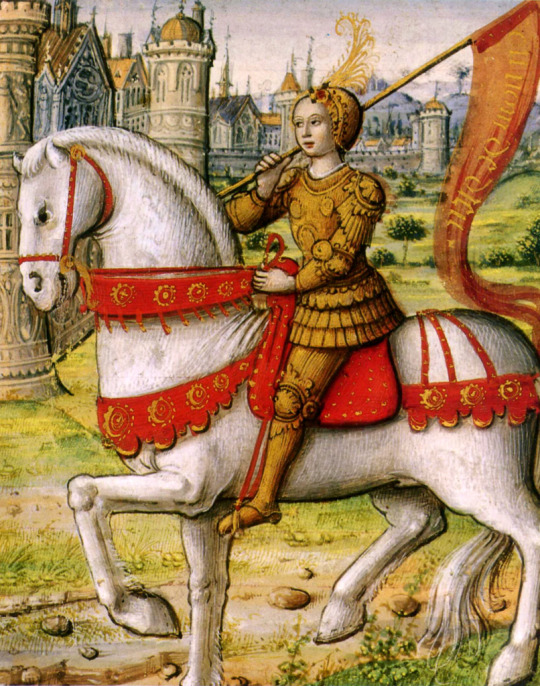
(Image Description: a 1504 painting of Joan on horseback. It is a bright painting on parchment. She is wearing shining armor with a yellow feather in her helmet. She carries a red banner. The horse is white with red and gold accoutrements and is prancing. There are fields and a castle behind her. Joan looks calm. End ID)
The argument could be made that it is impossible to untangle Joan's chastity from her religiousness. But I would argue that there is a way to tell and a way that hers is unique from that of other saints.
Within Catholicism chastity is about sacrifice and self-denial, by being sexless you are giving something up. That is why you will often see saints who are hermits, giving up sex along with everything else. Even saints who die as virgin martyrs (i.e. dying defending their virginity) are generally fending off rape or a marriage that would come between them and God. Unless they are willingly giving themselves up to God Himself chasteness is not supposed to last. Indeed, you are supposed to go forth and multiply and all that.
Officially in Catholic doctrine asexuality does not exist because sexual attraction (to the "opposite sex") is one of God's Gifts. It is impossible to not feel sexual attraction and be human in their eyes. As per an FAQ on religious life "Question: What do you call a person who is asexual? Answer: Not a person. Asexual people do not exist. Sexuality is a gift from God and thus a fundamental part of our human identity.". Or even more sinisterly as put by former Priest*** and Ugandan Ethics Minister Simon Lokodo when he said he approved of heterosexual child rape more than consentual gay sex "it is men raping girls. Which is natural" the implication being that hetero sex is the only "natural" thing, because even denial is unacceptable. Yes, Lokodo is an extreme example, but it reflects a mindset about heterosexual sex.
Chastity is only venerated in Christianity insofar as you are giving something up for God. The Christian faith has engineered the acceptable circumstances for sex and you are expected to have it and want it within those circumstances. Joan's maidenhood is traditionally viewed much the same way a nun's is, that she was driven by her love of God and her desire to fulfill His instructions and thus neglected her own desires. It is unthinkable that maybe she just didn't care, that she would rather be a warrior than a wife. She would be far less beloved if that was the widely agreed on conclusion, I assure you.
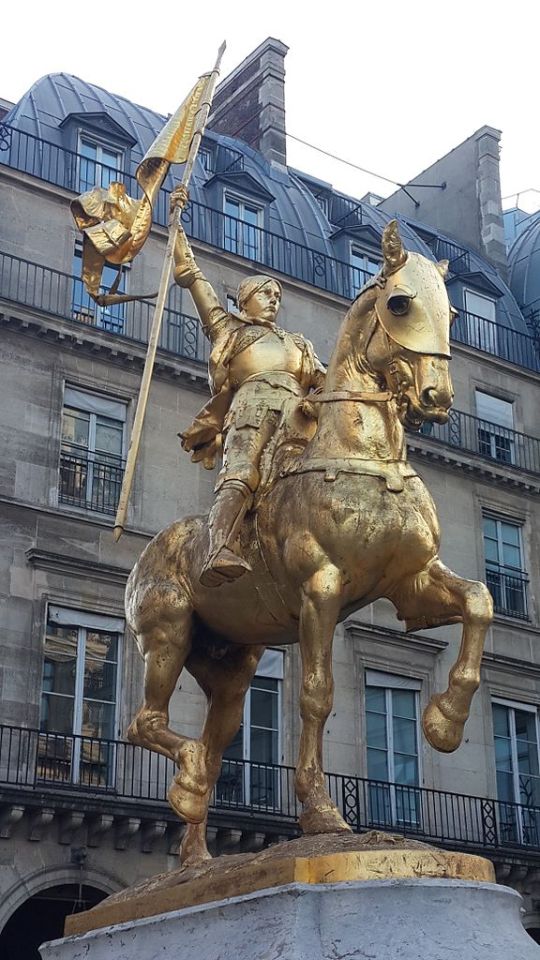
(Image description: Jeanne D'Arc (1874) a gilded bronze statue by Emmanuel Frémiet now at the Place des Pyramides, Paris. Commissioned by Napoleon III and standing 13 feet tall. It shows a triumphant Joan of Arc on horseback with her banner held high. Both she and her horse wear armor. End ID)
*The argument for this is actually pretty weak. The one thing I have seen used as evidence of her being definitively a lesbian is that she shared her bed with women. But this was the 15th century, bedsharing was extremely common, there weren't many beds to go around, whole peasant families might share a bed. Yes, it could mean something, but Occam's Razor, in an era when nonsexual bedsharing was common this is not proof this is was for sexual reasons, there is no reason Joan would be an exception. Without any other evidence she was a lesbian this is not enough to prove she was attracted to women. I am not saying it isn't possible, I am just saying that is not enough to go on.
**In her being GNC. Again, a possibility, but not definitive. Of course this stuff rarely is.
***He was removed from the priesthood when he entered politics as it is against Vatican law to hold both positions, it had nothing to do with his horrific stance on Queer Rights.
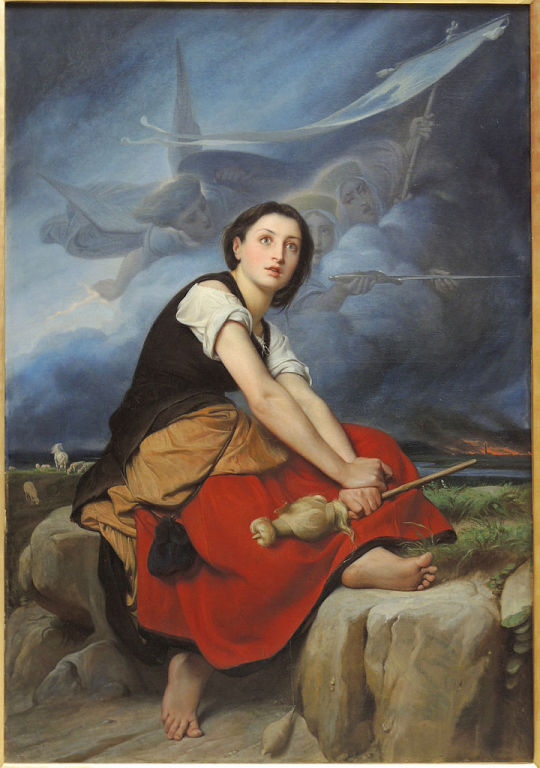
(Image Description: Jeanne d'Arc écoutant ses voix by Léon François Bénouville [done before 1859]. It is a painting that shows Joan when she first was visited by Saints/Angels. It shows Joan in layered but undecorated clothing. She is clutching what appears to be part of a loom or other wool working equipment in one hand. The other holds her wrist. She is white and pale and barefoot. Her hair is dark and partially pinned back, starting to come free. She has a round face and looks shocked, her doll like mouth agape in a gasp and her light eyes wide. She is seated on a rock with a field behind her, dotted with sheep and a horse. Far beyond her in the distance is a burning city. In the air around her in an immense sky are the flying and translucent forms of angels. They have their mouths open, calling to her. One offers her a sword another carries a flag/banner. End ID.)
Quotes:
"Jehanne la Pucelle"
-How Joan signed her dictated letters and referred to herself, "Joan the Maid".
"Alas! that my body, clean and whole, never been corrupted, today must be consumed and burnt to ashes!"
-Joan of Arc after being condemned to death, quoted by Jean Toutmouille
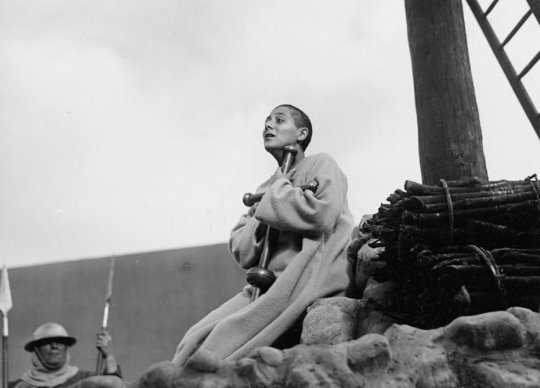
(Image Description: a still from La Passion de Jeanne d'Arc (The Passion of Joan of Arc) a silent film from 1928. It is widely regarded as a masterpiece and a landmark of early cinema. Renée Jeanne Falconetti (Joan) is still hailed for her performance. In this image we see Joan kneeling in front of the stake. She is wearing a wool robe and clutching a cross. The anguish on her face is indescribable. Behind her is an armed guard. End ID)
#lgbtq#queer#asexual#ace#history#aromantic#aro#soldiers#Europe#French#15th century#Joan of Arc#France#bio
59 notes
·
View notes
Text
Cramp’s Comic Recommendations For Fans Of Classic Rock And Co.
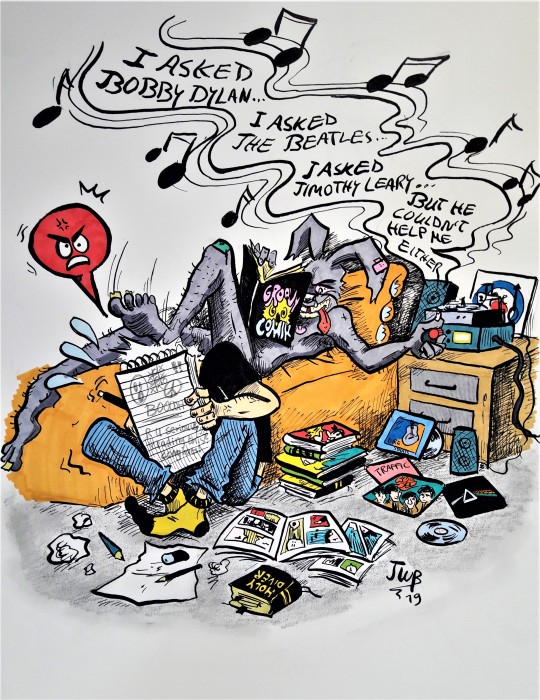
Allright here we go. This is my current list of comics/manga/graphic novels you might enjoy if you’re into classic rock. Before we get started I’d just like to let you all know:
- This list is far from being complete. I’m sure there are many more groovy comics out there that I’m simply not aware of yet so if you have any suggestions feel free to add them :)
- I know I said “Classic Rock” but some of my choices may drift into other musical directions
- Needless to say I do not own any of the following images. They all belong to their rightfull owners and I’ll use them as visual reference material only.
- Sorry for eventual misspelling
Let’s go ^^
1. Bob Dylan Revisited
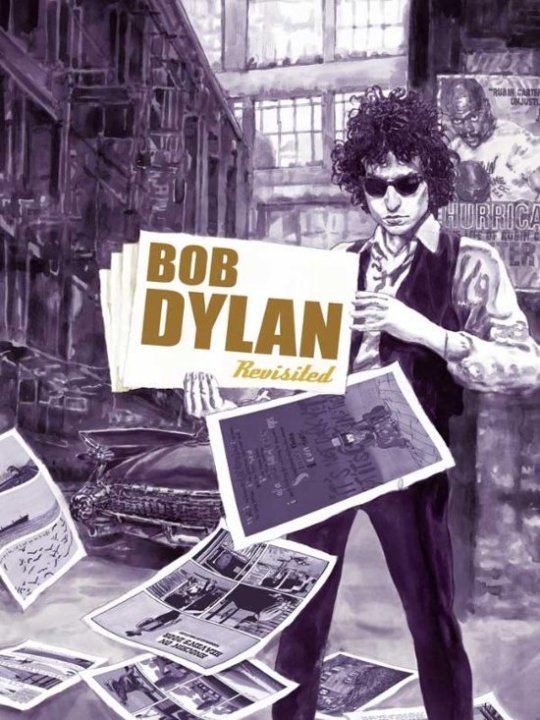
Let’s start with an obvious choice. This is a collection of 13 well-known Dylan Songs, each of them graphically interpreted by a different artist. The most striking feature therefore is the high variety of different art styles. Some of them are cartoony, some are very abstract while others are almost photo realistic.
Dylan’s mesmerizing lyrics have always been inspirational and these beautiful depictions truly are a sight to see.
Including works of Thierry Murat, Lorenzo Mattotti, Nicolas Nemiri, François Avril, Jean-Claude Götting, Christopher, Bézian, Dave McKean, Alfred, Raphaëlle Le Rio, Maël Le Mae, and Henri Meunier, Gradimir Smudju, Benjamin Flao, Jean-Phillippe Bramanti and Zep.

Zep’s take on “Not Dark Yet”
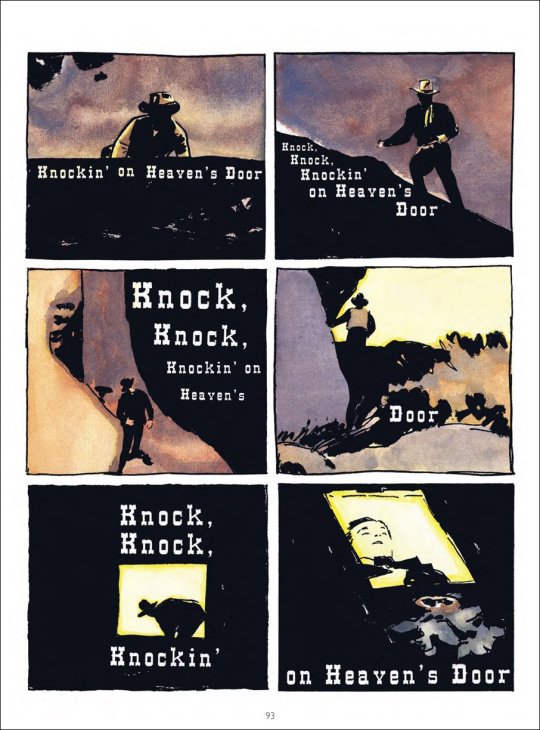
Jean-Phillippe Bramanti’s interpretation of “Knocking On Heaven’s Door”
Definitely worth checking out not only for Bob Dylan Fans.
2. Baby’s In Black” by Arne Bellstorf
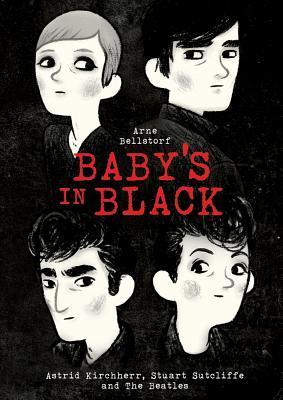
I’ve seen several people in the Beatles fandom complain about the lack of Stuart Sutcliffe material when it comes to early Beatles history.
Well, here it is: a graphic novel that focuses on the relationship between Stuart Sutcliffe and fotographer Astrid Kirchherr who took the very first professional photos of the Beatles during their time in Hamburg (1960-61).
Told mostly from Astrid’s point of view this comic presents itself in a grey and melancholic tone that fits the rather sad story. Bellstorf’s drawings are simplified and charming (they remind me of early sixties children book illustrations which suits the setting’s time period)
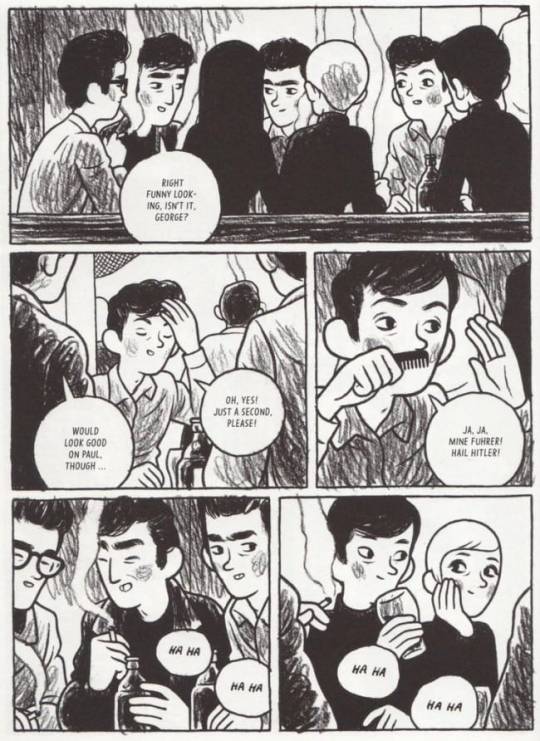
If you’re interested in early Beatles history (especially their Hamburg days) you should give this one a try.
3. Blue Monday by Chynna Clugston Flores
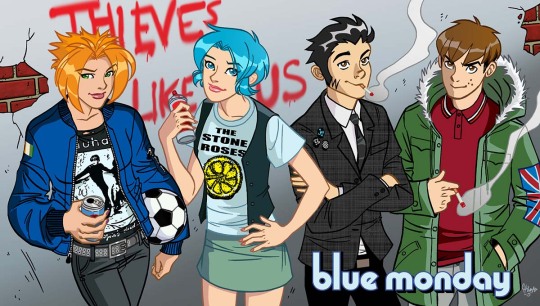
I really wish I had known about this amazing comic series a few years earlier, not only because this is a slice of life/coming of age story with teenage characters who are actually likeable and relateable but also because “Blue Monday” is an overall highly entertaining depiction of early nineties teen culture/rebellion in an American suburb that comes with a lot of references to Britpop, mod culture, Buster Keaton movies and Adam Ant (to name only a few).
To quote the author herself: “It’s like Archie on crack, with cursing and smokes”.
The art style of Chynna Clugston Flores is very vivid and expressive and has a certain stylistic touch of anime/manga (like a lot of comics from the early 2000s). I also really enjoy all of the graphic fashion details in this one. Plus, this is the first comic with it’s own soundtrack and that’s always a nice bonus.
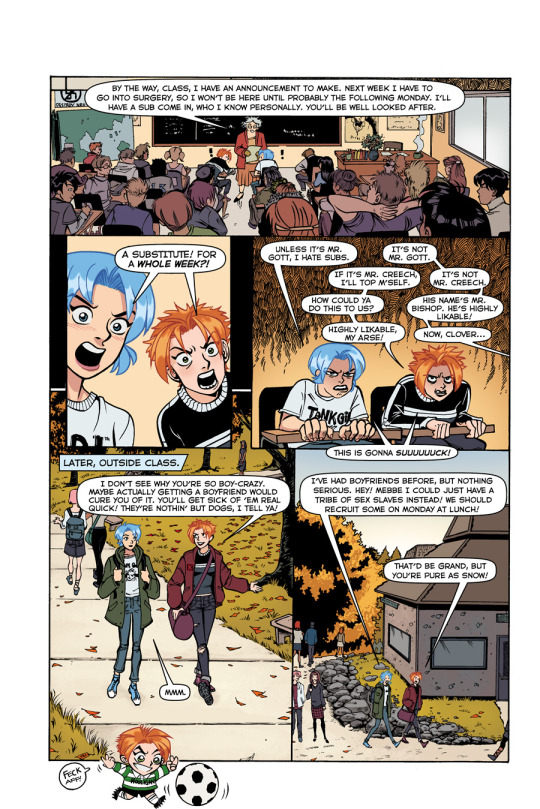
I’d recommend “Blue Monday” for fans of Britpop, Punk, New Wave and early 1990′s culture.
4. Punk Rock And Trailer Parks by Derf Backderf
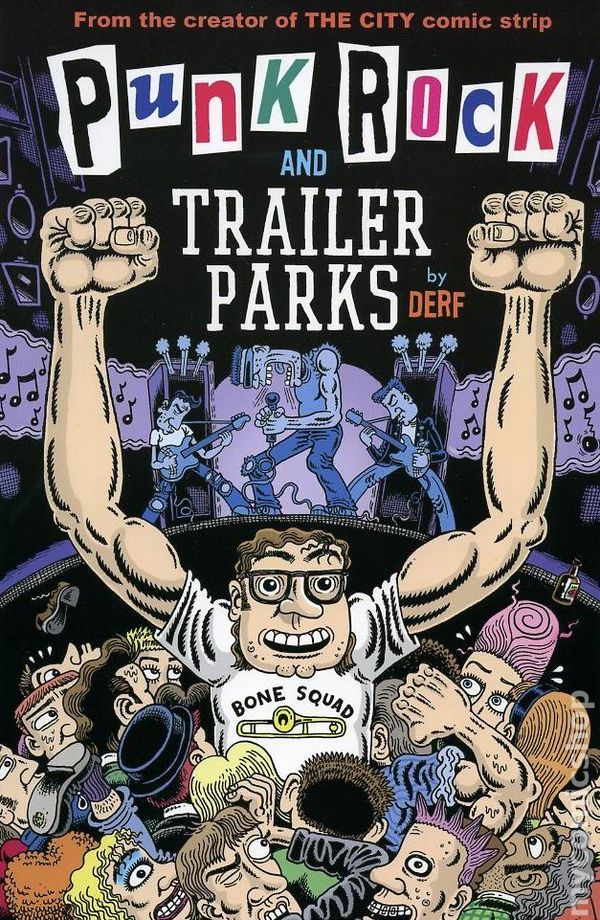
Another story about growing up in American small town madness, this time set in 1980s gritty Punk subculture of the former rubber city of Akron, Ohio. Protagonist Otto who likes to refer to himself as “The Baron” becomes fascinated with Punk after attending a Ramones concert. He meets several Pubk icons (thus as The Clash, The Plasmatics, rock journalist Lester Bangs and many more) and becomes someting of a local punk star himself.
Derf Backderf (who is best known for his highly acclaimed graphic novel “My Friend Dahmer” and his Eisner award winning comic “Trashed”) created a comic that is as “raw and dirty as punk itself”. His art style is an unique combination of expressionism, underground cartoons and punk magazines.
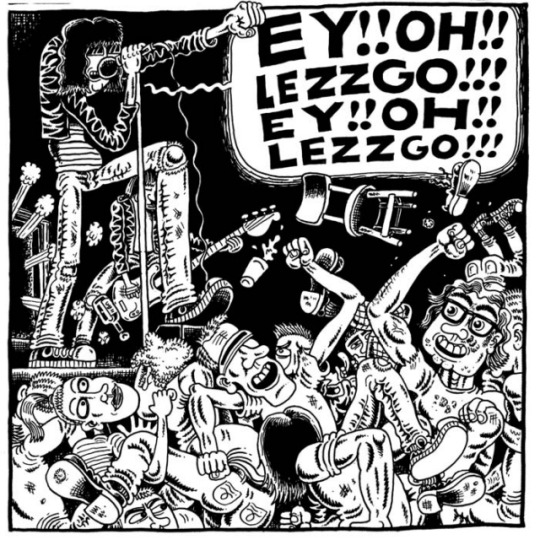

“Punk Rock And Trailer Parks” is a must-have for punk fans (especially if you’re into The Ramones and The Clash. It made me a huge fan of both of them).
5. “CASH - I See A Darkness” and “Nick Cave - Mercy On Me” by Reinhard Kleist
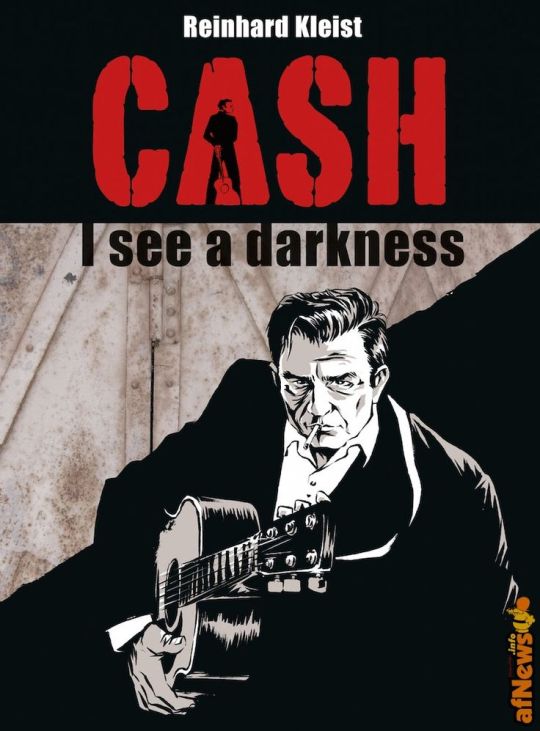

Two biographical graphic novels by Reinhard Kleist, both of them tell the story of a fascinating personality in rock history and both of them are incredibly well drawn. Kleist’s art is full of life and movement and very atmospheric due to his impressive use of stark contrasts.
I personally love his semirealistic way of drawing people and I’d highly suggest you to check out his other works too. He made a lot of biographical comics that really amazed me.
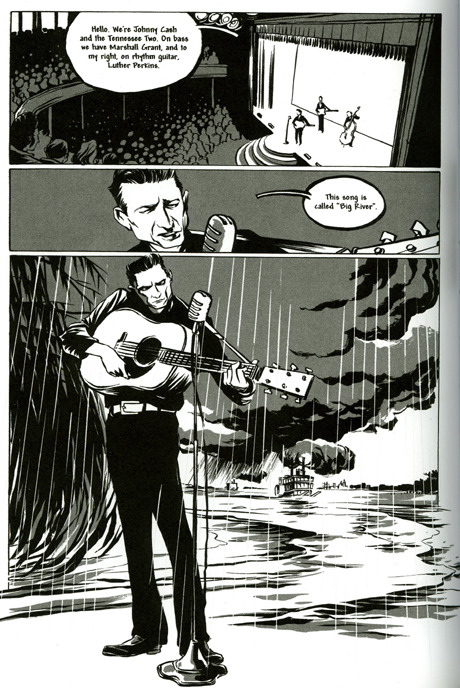
CASH

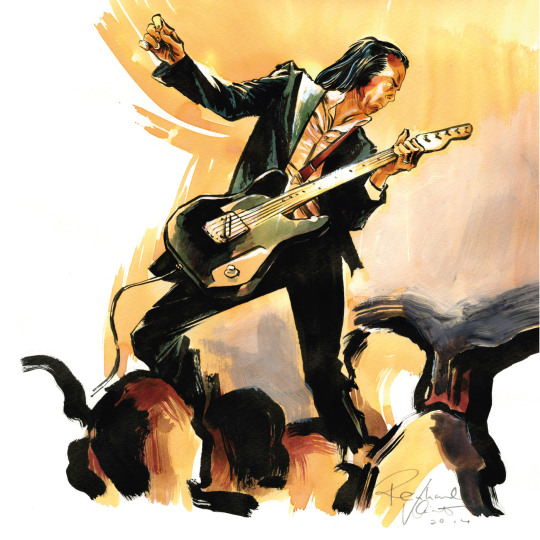
Cave
Definetly worth reading. Not only for Johnny Cash and Nick Cave fans.
6. Nowhere Men by Eric Stephenson, Nate Bellegarde, Jordie Bellaire and Fonografiks
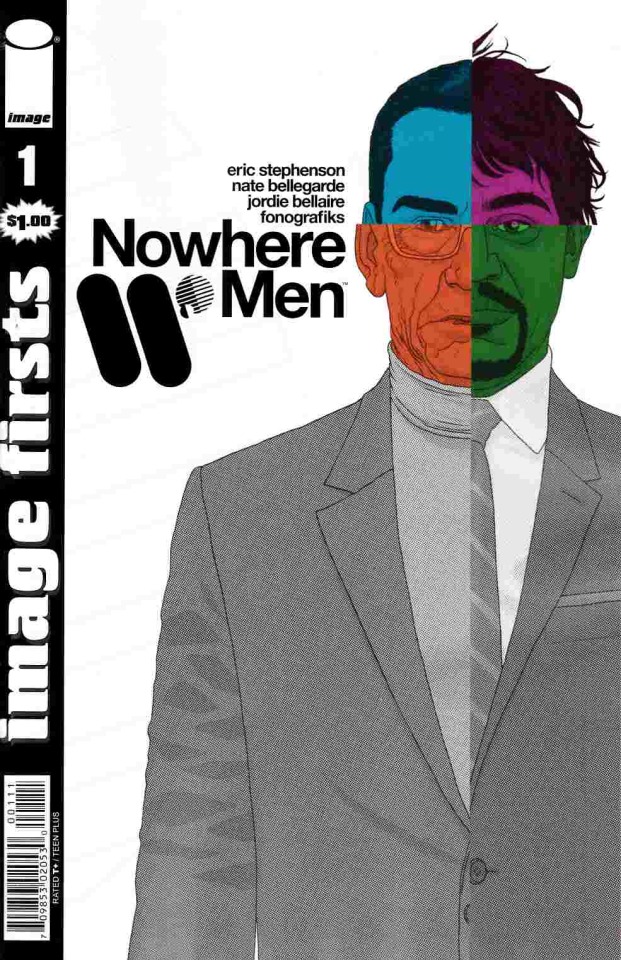
I talked about this one a while ago but I’ll gladly do it again since it’s just too cool. “Nowhere Men” is set in an alternative past/present and future where scientists became as popular as pop stars (catchphrase “Science is the new Rock n` Roll”) but somewhere along the way something definetly went wrong.
The hype of science shares obvious similarities with the beatlemania of the 60s and the founding of Apple back then. Furthermore, the characters are partly inspired by well-known personalities of Rock history. There are many more or less hidden nods and references to musical popculture wich is why I put it on this list.
Nowhere Men is a thrilling sci-fi dystopian that requires an observant reader because there is a lot of jumping back and forth i time and inbetween information. The art style is realistic and full of very vibrant colours.

I found myself reading this multiple times to get all of the details in the world building. A thoughtful and brilliant writing indeed.
7. P.I.L. by Mari Yamazaki
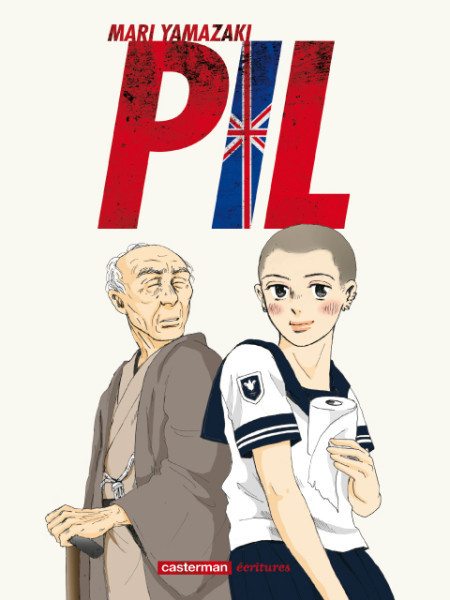
Japan 1983: 17-year-old Nanami couldn’t be more frustrated. Her grandfather loves to spend all of their household money on useless luxury junk and her strict school criticizes her messy hairstyle. Caught between teenage rebellion and responsibility as she tries different side jobs to earn at least a little bit of money, Nanami also has a thing for punk music and overall everything originated from England.
P.I.L. tells the story of conflict between two generations who aren’t as different as they might seem. Sometimes funny and heartwarming, sometimes with a bit of drama this is a charming slice of life/ coming of age josei with a more simplistic but aesthetical pleasing art style.
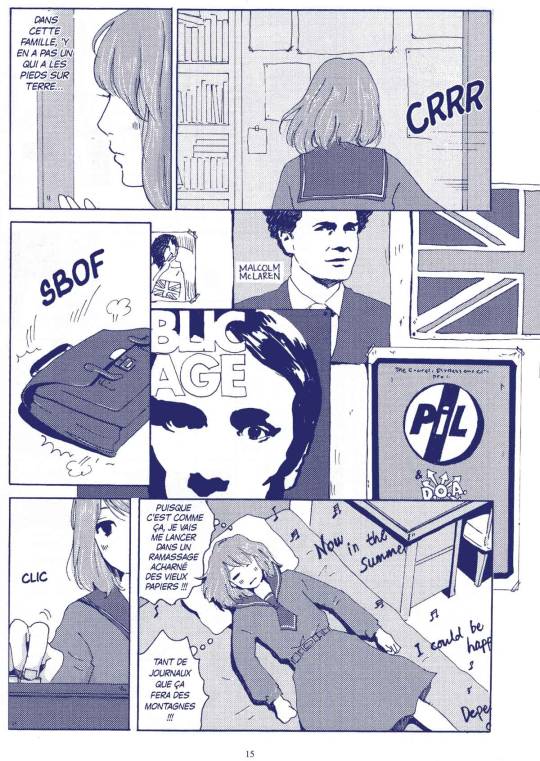
as the title might suggest, Nanami is a big fan of P.I.L. and other bands of the punk, neo punk and new wave movement such as The Stranglers and The Killing Joke
8. Yellow Submarine by Bill Morrison
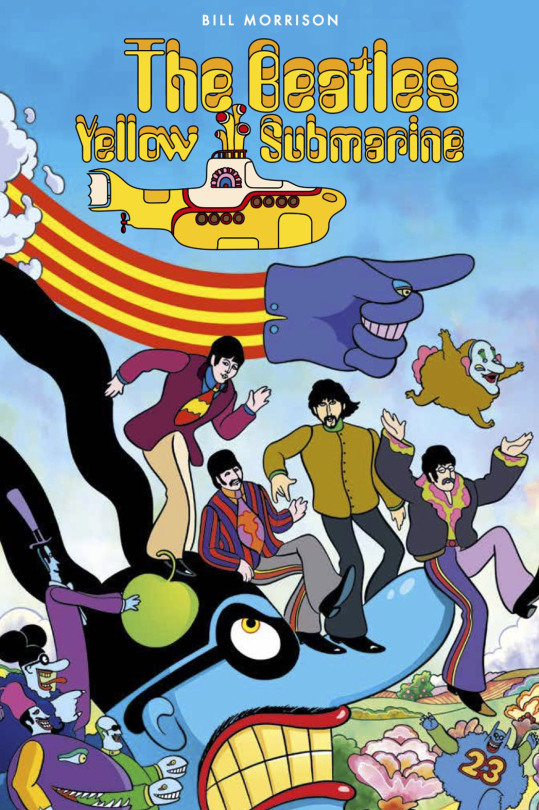
A comic adaptation of an animated film such as Yellow Submarine? Yeah, I was skeptical at first too but hear me out: This is really great. Morrison did an amazing job at capturing the trippy and psychedelic feeling of the legendary Beatles film. As the 1968 film used the medium of animation as an actual form of art to accomplish things only animation can do, Morrison did the same thing and used the advantages of the comic medium to accomplish things only comics can do. And it works. It really works.
Every single page of this colourful book has a different panel layout. Some of them are so beautiful and creative that I’d love to have a full-size poster version of them :’D
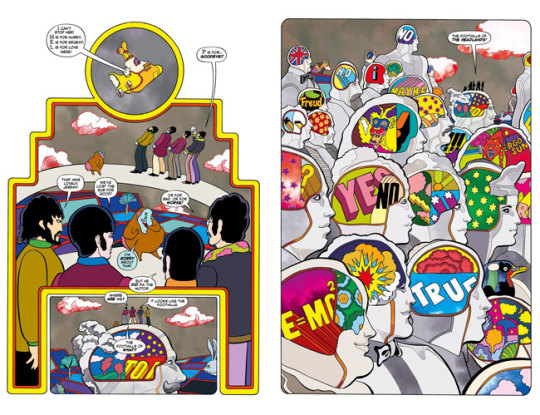
If you liked the film, if you love the psychedelic age, you’ll probably like the comic too.
9. In The Pines by Erik Kriek
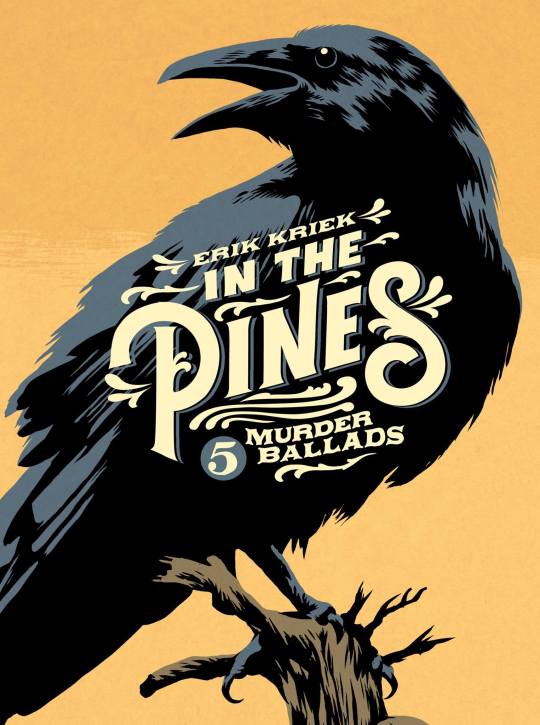
“In the pines, in the pines, where the sun never shines...”
5 Murder Ballads, some might call them dark Country Music, each of them beautifully illustrated by Erik Kriek. Atmospheric, dark and gritty and always on point to match the spine-chilling western-like storytelling of these ballads, great for fans of horror literature a la E.A.Poe.
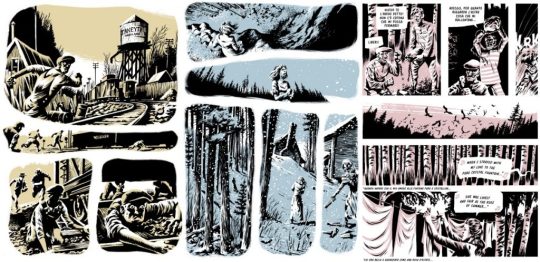
10. Andy - A Factual Fairy Tale by Typex
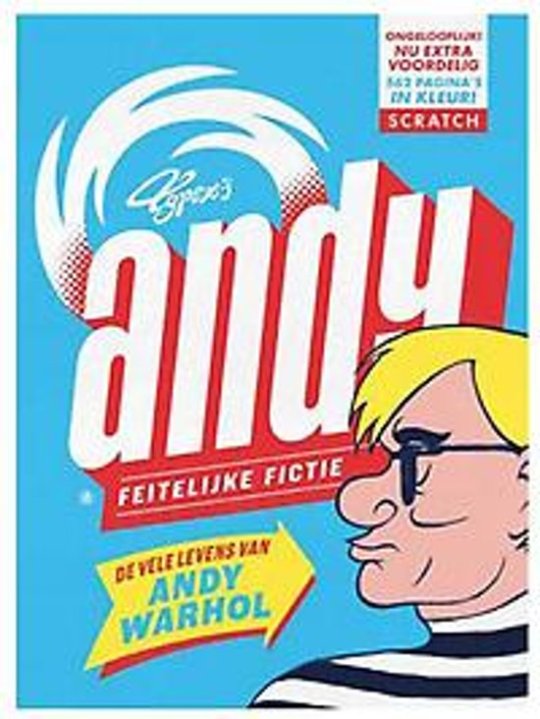
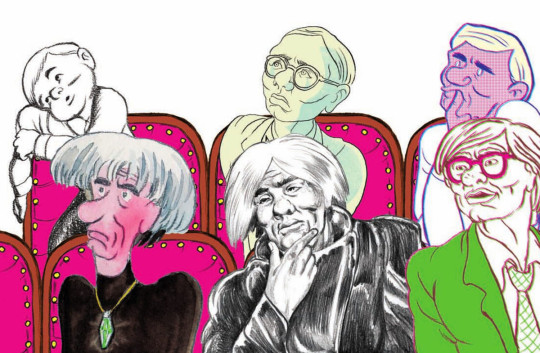
Allright folks this is it:
Typex’s “Andy” is by far one of the best comics/graphic novels I’ve ever red. It defenitely is my personal favourite reading of 2019 (and tbh I kinda doubt anything will top this anytime soon)
This is more than just a biographical take on of the most enigmatic pop-art artists of 20th centuary’s America, this is a portrait of the 20th centuary itself. There are so many references to art, history, literature, music and more that I could fill a book counting them all. And of course this is a monument for the medium of comic itself. Typex really managed to show what comic’s are capable of (At this point I’m really sorry I can’t explain it better I’m not good in writing stuff like this yet...)
Visually one of the most appealing things are the different art styles Typex manages to pull off so well for every chapter in Warhol’s life because each of them are a mirror of their zeitgeist. The introduction of Warhol’s childhood during the 30s is drawn in a cartoony style of old news paper comic strips. The chapter of 1967 has a psychedelic edge. The chapter of the early 60s shows similarities with the works of Roy Liechtenstein
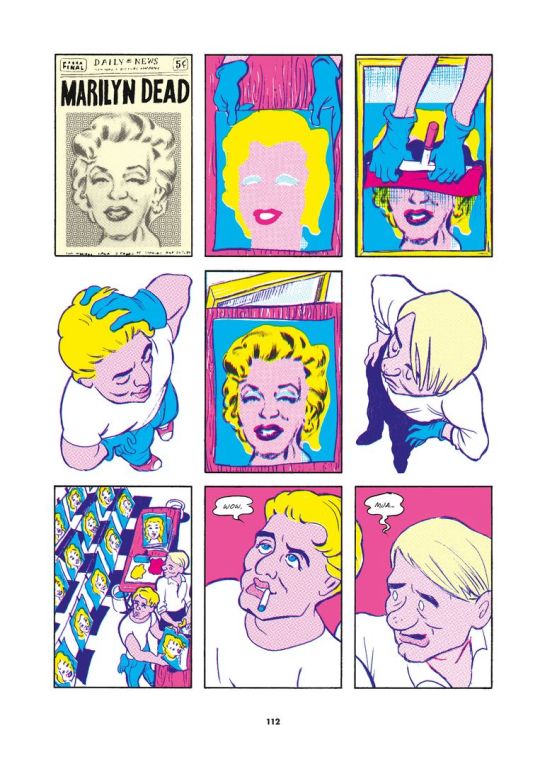
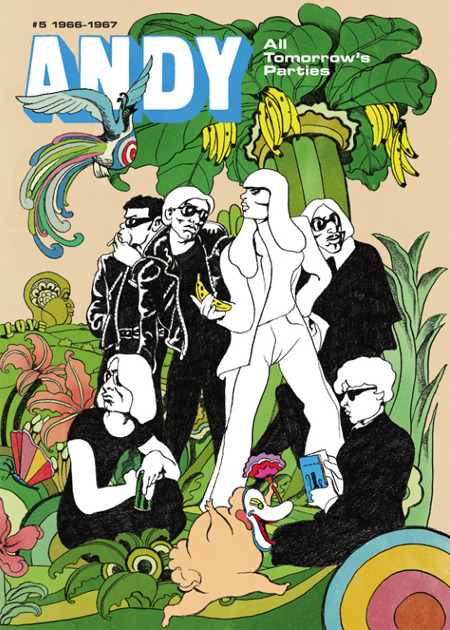
So many icons from the 1930s-1980s have a cameo in this graphic novel it’s just amazing. If you’re even remotely interested in anything of this time period you’d definitely should read this. (seriously, READ THIS). But at this point I’d also like to mention that this comic does not shy away from showing very explicit content and sensetive topics (please keep in mind this has a mature rating for a reason)
Yeah so I couldn’t give this piece of art enough praise. It is absolutely brilliant, a masterpiece in every sense and word.I wasn’t too aware of Typex before but appearentely he also did a graphic novel on Rembrandt. I’m gonna read this too.
Some honorable mentions:

California Dreamin` by Penelope Bagieu
I haven’t red this one yet so I can’t say anything more about it. But I wanted to let you know that a graphic novel about the life of Cass Elliot exists.
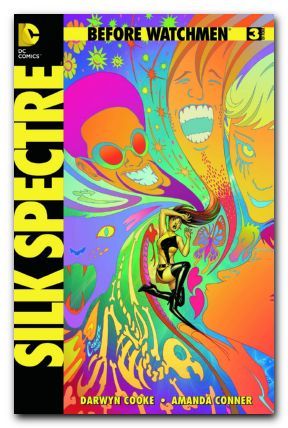
Before Watchmen: Silk Spectre by Darwyn Cooke and Amanda Conner
One of the prequels of the legendary “Watchmen” by Alan Moore and Dave Gibbons. It’ “only” an honorable mention because you’ll have to be familiar with the Watchmen universe to fully get all of the story. This prequel focuses on Laurie Jupeczyk, the second Silk Spectre and her own adventures during 1967, the summer of love in San Francisco.
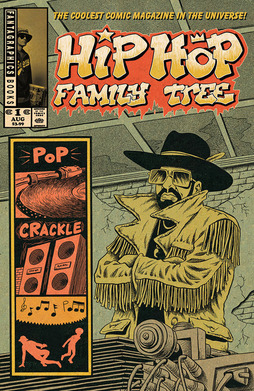
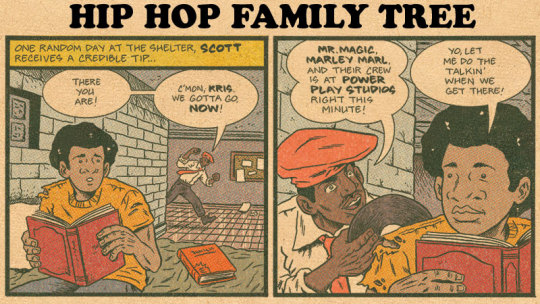
Hip Hop Family Tree by Ed Piskor
Another one I haven’t fully red yet, but so far I’m loving it. It basically tells the history of Rap and Hip Hop from the early 70s to the mid 80s. The art style is intentionally old-school wich really fits it’s tone and setting.
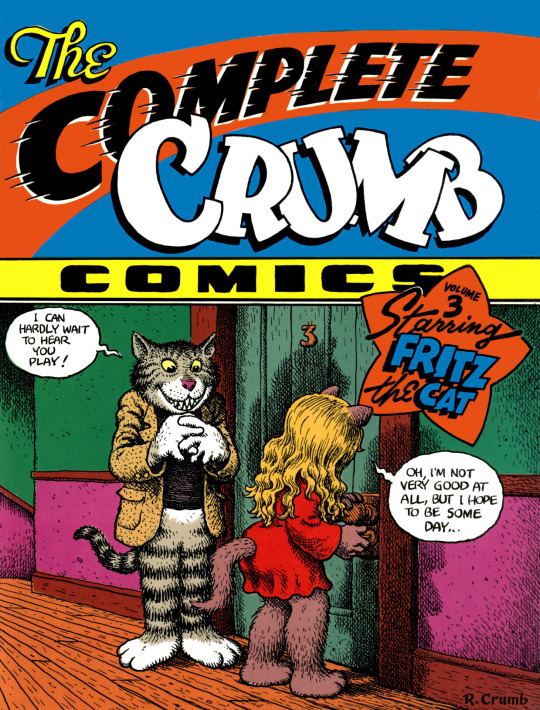
Fritz The Cat by Robert Crumb
I suppose I can’t make a list like this without at least mentioning an absolut icon of the underground comix movement. Crumb created the adventures of this nasty junky cat during the 60s. Fritz can be seen as a satirical mirror of counter-culture’s zeitgeist.
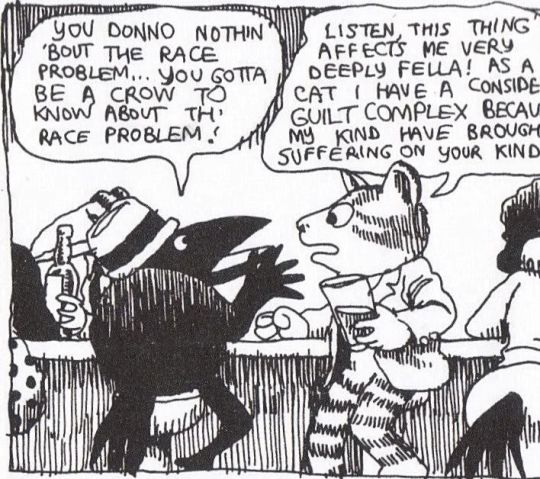
and speaking of Crumb, his “Heroes of Blues, Jazz and Country” trading cards are neat too...

allright that’s it for now. like I said, if you have anymore suggestions, feel free to add ^^
#long post#Cramp talks#classic rock fandom#comic#thierry murat#lorenzo mattotti#nicolas nemiri#francois avril#jean-claude götting#christopher#bezian#dave mckean#alfred#raphaelle le rio#mael le mae#henri meunier#eric stephenson#Nate Bellegarde#jordie bellaire#fonografiks#ed piskor#erik kriek#derf backderf#arne bellstorf#penelope bagieu#mari yamazaki#robert crumb#typex#reinhard kleist#chynna clugston flores
41 notes
·
View notes
Photo

I Shot Andy Warhol (1996) is a dynamic, true crime, avante garde film that explores the history and complexity of the relationship between famous artist Andy Warhol and radical feminist Valerie Solonas. The true events depicted in this film are told through a mixture of narratives that both highlight the socio-political climate of the 1960s and the struggle for female identifying empowerment. I thought it was particularly interesting that the film was first intended to be a documentary about Valerie Solonas, but the filmmakers could not find enough footage of her, nor any individuals to speak about her. Throughout the film, the various narrative perspectives mirror a documentary styled memoir. Mary Harron tells Valerie’s narrative using a combination of flashback narratives, self recorded home videos of ‘Valerie’ reading from her own Manifesto as it pertains to the current storyline, and an unnamed character reading Valerie’s file referring to her as ‘the patient’. The last narrative technique allows the viewers to gain some context surrounding both Valerie’s intentions and behaviors. The unnamed narrator discloses Valerie’s history with being molested, prostitution, homosexual activity, and ultimately her belief in ‘the natural superiortiy of women over men’. These biographical narratives ultimately illustrate a much bigger picture than just the relationship between the two. . The key themes highlighted in I Shot Andy Warhol include superiority, ironic male validation, radical feminism + matriarchy, mental illness, revolution, lesbianism, and revenge. . Valerie’s detrimental motives as a protagonist in this film are driven by her attitudes toward female superiority over men. Valerie’s constant push to educate the masses on her S.C.U.M Manifesto (Society for Cutting Up Men) is bound by the idea that women are biologically superior. Within this superiority complex is a duality of anti-man rhetoric, paired with using men for her advantage when she needs to. I found it ironic that while Valerie is so anti man, a recurrent theme in the film is the chase for male validation; especially Andy. From the first time Andy Warhol’s name is mentioned in the film, Valerie is desperate to get Andy’s attention in hopes that his connections and artistry will help her spread her radical views through media. Valerie constantly pushes her beliefs onto Andy and even gives him the only other copy she has of her screenplay for him to read. Even after begging Andy to read it, he dodges Valerie’s push for production but still holds onto her beloved copy. This stands as a symbol of Andy still holding a piece of ownership over her but refusing to give her the validation she is chasing. As mentioned in the original report, Valerie’s erratic behavior and radical beliefs stem from a comorbidity of mental illness, likely OCD and Schizophrenia. It is revealed at the end that Valerie is sent to a ‘Hospital for the Criminally Insane’ following the shooting. While it is unclear to the audience whether or not Valerie realizes her diagnosis, Valerie’s mental health is obvious to the other characters. Valerie sees herself as a revolutionary, while others (specifically men) consistently label Valerie as a ‘lunatic’ and insane for her beliefs. There is a wide gap in perspective from Valerie’s view of herself versus other’s interpretation of her. . The cinematic aspects of the film were what captivated me the most while watching. One recurrent technique throughout the film was the specific and deliberate use of the color red, red lighting in particular. The first time Valerie visits The Factory trying to find Andy, the lighting surrounding her is a shadowy, transparent red glimmer focused on her face. When Valerie goes to meet with the publisher to sign her book contract, she specifically picks out and wears a red dress. After being ‘excommunicated’ from Andy and his group and going to confront him, there is dark red light surrounding the group as they walk out of a tunnel. However, when Valerie’s face enters the frame to speak to Andy, the red light behind the group disappears and the light shown on Valerie’s face is harsh and bright white. The repetitive incorporation of the color red stands in as a symbol for many emotions and moods, such as: embarrassment, frustration, humiliation, bloodlust, romance, need for validation, and superiority. . The visual techniques during the party scene at The Factory were especially noticeable. The bright, saturated, revolving and color changing lights stood to amplify the mood of the party for those in attendance. The mixture of light movement paired with diverse colors and patterns added a layer of intoxication to the scene and reflected how the party-goers were feeling under the influence. . I think the most important cinematic aspect in this film were the deliberate mirroring shots to tell different aspects of the same narrative. During the scene of the party at The Factory, both Andy and Valerie are surrounded by people but standing alone. They both slowly look up and make eye contact with one another from across the room as the camera pans in on each individual. The last scene of the film depicts Andy standing in a crowd surrounded by others, when he hears a popping sound reminiscent of a gunshot. This triggers Andy to turn around as he sees Valerie standing alone directly across the street. The two once again make eye contact, and in the same angle as before, the camera pans into both individuals’ reactions. Andy stares nervously and Valerie disappears after a car passes by. While both shots mirror one another in technique, the emotion and context behind both are drastically different. The first implicates admiration and need for validation, while the final shot indicates fear from Andy and accomplishment from Valerie. . Many aspects of the film are reflective of the time period being portrayed in the film. As mentioned in the original report, this film took place during the Vietnam War in the 1960s, where the socio-political climate was extremely volatile and filled with protest and anti-government and anti-war sentiments. While I do not think anti-war attitudes were presented at the forefront of this film, or even mentioned more than once, I do think that Valerie’s passionate and revolutionary motives were inspired from the political climate during this time period. . The set design and costumes were also extremely reflective of the 1960s. The ‘retro’ aesthetic of this time period can be found within sets such as the old fashioned classic diner and especially The Factory. A ‘cinema fact’ on the back of the DVD case revealed that Harron and the filmmakers were given permission to reproduce some of Andy Warhol’s paintings and silk screen for the set, but they had to destroy them after filming. One could argue that the set of The Factory is more reminiscent of Andy Warhol’s artistry, which is ultimately a reflection of his peak during this time period. . Even attitudes of the characters were reflective of the oppression of certain identities during this time, especially lesbians and trans people. Valerie is consistently degraded by the men around her for being a lesbian, most harshly insulted when she was the only woman in the room. Feminine heterosexual women portrayed in the film were also degraded and stereotyped, but in a hypersexualized way that the men validated as attraction. Degradation towards Valerie came from a homophobic standpoint that was not based on attraction. For example, when Valerie appeared on the television interview, the man rudely demeaning her while discussing the ‘controversial’ topic of homosexuality cited the Kinsey Reports. Debuted in the late 1950s, the Kinsey Reports introduced the concept of sexuality as a spectrum and changed the way a lot of people viewed homosexuality in general, for better or worse. . I think one thing that stuck out to me the most throughout the course of the film was that it seemed as if S.C.U.M. and its manifesto was inclusive of all womxn identities. Even the ad in the newspaper seeking actors to audition for the screenplay “Up Your Ass” directly welcomed ‘butch dyke lesbians’ and queer people. However, towards the end of the film when Valerie was convinced that Candy had worked with Andy to set her up, Valerie cruelly invalidated Candy’s identity as a transwoman and called her a man. This invalidation is not only misogynistic and exclusive to trans people but is especially demeaning to say to a friend who originally brought you into the scene. At first I was excited and even surprised to see trans representation within the film. Although it was disappointing to see transphobia shine through, especially from Valerie, this type of fear and intolerance was common and is still common surrounding trans identities. . It was fairly hard for me to actually get a physical copy of and view this film, and I believe it was well worth the difficulty. This film is an intimate storyline of a historic and iconic incident that stands to narrate more than just a dynamic relationship. – ECo
2 notes
·
View notes
Text
¡Que Viva Changó! -Exploring the popularity of Changó in Cuba.
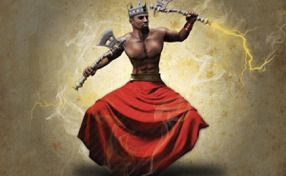
(Image 1: Changó, dios de trueno)
Background
The transatlantic slave trade saw not only the movement of people from West Africa to the Caribbean and South American continent, but also the spread and evolution of hybrid religious practices stemming from a shared pantheon of Yorùbá deities from Southern Nigeria.
The African Diaspora developed these religious practices across a wide geographical area and under different systems of colonial rule which lead to differences in names and spellings as well as morphing religious with the beliefs with those of the oppressors to guarantee clandestine survival. Here I focus on Cuba where African deities are equated with Roman Catholic saints (Welsh, 2001) and are survived not only in religious practise but in popular music.
Who is Changó?
Known as: Sàngó in Africa, Xangó in Brazil and Changó or Shangó in Cuba, Changó is a strong warrior deity connected to thunder and fire and associated with the colours red and white. Ernesto Pichardo, worshipper and ‘child’ of Changó describes him as:
‘Thunder and lightning. Justice and truth, warrior and king. Dancer, owner of the sacred Bàtá drums, original diviner[…] Excellent strategist in warfare. Excellent governor of people. Always present where there is injustice. Brings order where there is confusion. These are ways in which people describe him[…]’ (Mason & Pichardo, 2009)
His popularity and prominence in Cuban popular music makes me wonder: why Changó? There are many other deities in the pantheons of Cuba’s Santeria and Lucumi, each with their own attributes, powers and ritual, yet Changó stands out.
In ‘Ochun con Changó’ Celia Cruz very clearly describes the deity and her feelings towards him:
Él es el macho fuerte siempre de rojo y blanco
He is the strongest always in red and white
Con su espada en la mano guerrero y emperador
With his sword in hand warrior and emperor
Oshun con Changó, Changó con Oshun
Oshun with Changó, Changó with Oshun
Ellos son mis orishas y yo los quiero a los dos
They are my orishas and I love them both
Akínyemi defines Changó as one of the most powerful and universally worshipped Yorùbá deities in the (African) Diaspora, and goes on to explain his multi faceted traits that could be attributed to causing this:
‘…the prestigious position that Sàngó [Changó] occupies among the Yorùbá people stemmed from his association with Òyó royalty and the institution of kingship, his specialised divination system[…] his commitment to social justice, his association with thunder and lightning, his military might and pursuit of the two main themes of a warrior culture - prowess and honour - both of which his devotees believed were part of the reason he did an enormous variety of things towards their improvement and for humanity in general’ (Akínyemi, 2009)
This gives insight into Changó’s position and appeal within the pantheon but does not explain his particular popularity in Cuba.
In ‘Saludo a Changó’ Company Segundo covertly refers to Changó as papa (father) singing: ‘Pa saludar a papá ‘ - say hello to father - meaning Changó. This reference could be easily missed were it not for the closing refrain where he sings: ‘Obaé obayana yana’ which is in the Yorùbá language and translates as ‘my father is here’. Religious practices often use African derived languages and this use of Yorùbá acts as a coded reference, aligning him to these practices. It is hidden to those who do not understand it, but an obvious statement to those who do, hiding in plain sight.
Orisha Royalty?
Although not explicitly a leader of the other deities, Changó has an elevated status often described as regal:
‘…in the diaspora, where Sàngó [Changó] is syncretised as Saint Barbara (as in Cuba)[…] his association with Òyó royalty is still recognised, and he is subsequently accorded royal respect[…] he is regarded as the divinity of thunder and lightning[…] and he dances to the rhythm of the Bàtá drum beaten in a virile, warlike, dignified and kingly fashion.’ (Akínyemi, 2009.)
Could this royal association be the source for his popularity? The evidence within songs does not suggest so. Although he is described as having royal status by scholars with regard to ritual practise, there is no evidence of this in popular Cuban music which could explain his popularity there.
In ‘Changó ta veni’ Celia Cruz sings enthusiastically in a major key uptempo track that demonstrates excitement at his arrival, however there is no further lyrical elaboration as to specifically why this is:
Con el machete en la mano tierra va temblar
With machete in hand the earth will tremble
Changó ta veni
Changó is coming
The Power of Changó
Changó has control of thunder, lightning and fire which as strong elements undoubtedly give a certain appeal, however his power also extends past this. Changó has the ability to resolve all kinds of human problems (both spiritual and physical) through his mysterious and mythical power. His superhuman nature is demonstrated in his military might and ability to provide physical protection for his followers’ (Akínyemi, 2009)
The group N.G La Banda appeal to this power in their song ‘Papa Changó’ where the lyrics to their heavily rhythmic track state:
¡Que miedo que volverias!
How scary it is that you could return!
Papa Chango […]
Father Changó[…]
Darme la luz mi padre, darme la luz […]
give me the light my father, give me the light […]
a matar muchos enemigos […]
to kill many enemies […]
So we can see here how the physical power of Changó is appealing and called upon in a devotional way in the song. However the request of powerful help has not only been asked for in the immediate present for dispatching enemies; the history of slavery itself can be seen as just cause for people to turn to Changó for help and guidance:
‘The protective power of Sàngó is well recognised and appreciated by his devotees in the Diaspora. Since Sàngó worshippers in the New World developed from a background of slavery in an atmosphere of bondage and suffering, the deity is often called upon in their chants as an instrument of deliverance.’ (Akínyemi, 2009)
The suffering through slavery that brought these deities to Cuba demonstrates why a powerful deity like Changó would be held in high regard as a saviour for the oppressed. However we can attribute this to Changó’s survival in the New World, but it still doesn’t account for his popularity., the reasons for which are more specific.
Musical heritage as cultural identity.
So still the question remains: Why Changó?
To answer this we need to look at cultural heritage, preservation and reinvention in Cuba.
The slave trade brought people and with them their religious belief systems also made the Atlantic crossing. As Lovejoy explains:
‘Easily identifiable cultural icons, such as Bàtá drums, can reveal the conscious efforts of people to reestablish institutions of their homeland, even if only in symbolic and ritualised forms associated with religion, in this case òrìshà worship’ (Lovejoy, 2009)
And with this, most importantly:
‘Bàtá drums in Cuba also have an important relationship to Changó in that they belong to him’ (Lovejoy, 2009)
In Cuba, programs such as the government funded Casa de las Américas strengthened pan-Caribbean and pan-African cultural links through arts preservation and economic support.
‘Cuba is exceptional in the Spanish Caribbean in the degree of attention it has given to its links - historical, cultural and ideological - with Africa.’ (Pacini Hernandez, 1998)
And this even saw the ministry of culture elevate the status of Rumba to a national cultural symbol.
‘Rumba[…]has emerged as a national symbol of twentieth century Cuban society’ (Payne Daniel, 1991)
Through the use of bàtá drums Rumba is heavily connected to Changó so in effect, Changó was being promoted yet hidden in plain sight under the guise of Rumba music and dance.
We can see this clearly in tracks like ‘Elube Changó’ by the Afro Cuban Allstars, ‘Que viva Changó’ by Lazarito Valdés and ‘Highway One (Changó’s Dance)’ by the Bobby Matos Afro Cuban Jazz Ensemble. These all display Rumba musical features, either in vocal call and response style, harmony, the use of the rumba clave or in more general polyrhythmic rhythm parts. All of these reference Changó in their titles, yet don’t describe or make a devotion to him. He is the focus through the Rumba musical features which are integral to the tracks which clearly supports the idea that with the promotion of Rumba naturally came the promotion of Changó which can explain such a level of his popularity.
Machismo and Changó?
Leaving aside the influence that the promotion of Rumba and black Cuban culture had on the popularity of Changó for a moment, can we see any influence from wider Cuban society?
Often described as ‘machismo’, could the cultural landscape of Cuba of had a natural affinity with the virile and strong warrior deity Changó?
‘…an atmosphere of lingering machismo - the emphasis on being a male, male virility, superiority of men over women. Men are still the dominant group in Cuba. Notions of superiority and defence are embedded in their attitudes and behaviours and both men and women are products of an historic machista culture.’ (Payne Daniel, 1991)
We cannot debate the nature of the culture, only to say that yes on an individual basis Changó might have an appeal due to his ‘macho’ qualities, however we know that African deities were hidden in Cabildo worship by merging or disguising them as Catholic saints based on common features of iconography or traits, e.g the virgin Mary wears blue and white clothing and so does the sea deity Yemayá, so they are paired together through their shared colours. Changó is paired with Saint Barbara who is a patron saint of the military in Catholicism and is often depicted wearing red and with lightning behind her. The military focus, red colour and lightning were enough to merge her with Changó in forced cabildo worship, but we can clearly see that Saint Barbara is female and Changó is male, yet this is not addressed as an issue.
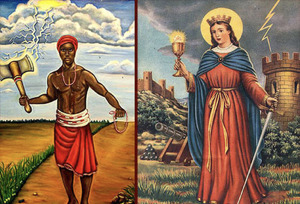
(Image 2: Saint Barbara and Changó)
In the Cuban classic ‘Santa Barbara’ by Celina y Reutilio y Su Conjunto Tipico (with many other artists’ versions available) we see the lyrics weighing heavily towards the Saint in the verses, only to name Changó in the chorus:
Virgen venerada y pura, Santa Bárbara bendita
Revered and pure virgin, blessed Saint Barbara
Nuestra oración favorita, llevamos hasta tu altura
Our favourite prayer, we rise up to your height
Que vive Changó
Changó lives
This use of both clarifies that they are merged as the same deity which dismisses claims that the popularity of Changó in Cuba is purely the result of the machismo culture, as the female saint and the male warrior deity are inextricably linked.
The Form of the Orishas
Finally, the nature of Changó as an entity must be recognised. As well as his physical abilities we need to take into account the Orisha system itself. All Orishas are connected in the pantheon when they ‘become active in the realm of others’. (Mason & Pichardo, 2009) So in this sense their strength and popularity can be seen as mutually dependent. Changó also has the very specific elemental traits of lightning and fire which Mason & Pichardo see as ever changing:
‘Since fire is associated with Changó, take that as an example. fire has not changed. Fire is fire, but its manifestation has changed and will continue to change…(about fully knowing Changó) You can never master it because it is always taking on new forms that make you go right back to square one[…]The influence of Changó’s blessings will vary[…] not in principle but in form.’ (Mason & Pichardo, 2009)
Conclusion:
‘The worship of Sàngó in the New World has thus become a strategy for survival and for freedom. Therefore, the deity is seen in the Diaspora as a national heroic symbol as well as a protective spiritual leader’ (Akínyemi, 2009)
Alongside this statement I argue that Changó has survived thanks to hiding and merging with the image of Saint Barbara, the ever changing forms his elements can manifest in and the strength of a co dependent pantheon of deities he belongs to. Changó has thrived under promotion as part of a Cuban cultural identity through Rumba music, as well as having a place as a spiritual link across the wider Caribbean and in Brazil thanks to his African roots.
Here I show the multiple possible routes that lead to Changó and thus his popularity in Cuba.
I call it ‘El Camino a Changó’ -(The route/way to Changó):
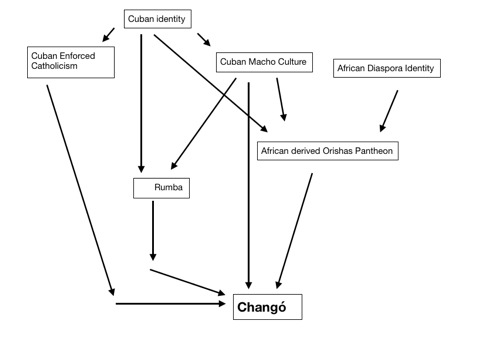
(Image 3: El Camino a Changó’)
The hip hop group ‘Orishas’ promote their identity as Cubans through their music and their song ‘Canto Para Elegua y Changó’ devotes a verse to Changó. The song shows Chango´s representative colours, connection to Saint Barbara, strength and guidance, the diversity of these come together to show why he is so popular:
Blanco y rojo represento[…]
White and red I represent[…]
Santa Bárbara bendita es tú Changó […]
Blessed Santa Bárbara is you - Changó[…]
Fuerza, esperanza, en ti confianza, con tu espada avanza[…]
Strength, hope, trust in you, with your sword advancing[…]
Guía por el bien camino a tus hijos, como yo[…]
Guide the way to your children, like me[…]
However I believe the most important of these features that have insured Changó’s popularity are his link to Rumba music and cultural identity. All bàtá drums are Changó’s and the inclusion of these drums in Rumba music means that his legacy will always continue as long as the musical tradition survives. With the government promotion of Rumba as a national symbol of Cuba, Changó’s fingerprint or DNA is promoted implicitly through music which strengthens Changó as part of a Cuban/Caribbean/African identity. It is perhaps more accurate to invert the visual image and in place of routes leading to Changó, in fact see the stretching reach that he spans.

(Image 4: ‘The Reach of Changó’)
References.
Audio Tracks:
Afro-Cuban Allstars - Elube Changó
Accessed online at: https://www.youtube.com/watch?v=rMTw0TLdTx8
Bobby Matos Afro Cuban Jazz Ensemble - Highway One (Changó’s Dance)
Accessed online at: https://www.youtube.com/watch?v=K5NLjKHFUY0
Lazarito Valdés - Que viva Changó
Accessed online at: https://www.youtube.com/watch?v=Uy10PcV-qZg
Bibliography:
Akínyemi, A. (2009) The Place of Sàngó in the Yorùbá Pantheon. In Tishken, J, E. Fálolá, T. & Akínyemi, A. (Ed.) Sàngó in Africa and the African Diaspora. Indiana University Press. (p. 24, 26, 32, 34, 35, 37)
Atwood Mason, M. Pichardo, E. (2009) Searching for Thunder: a Conversation About Changó. In Tishken, J, E. Fálolá, T. & Akínyemi, A. (Ed.) Sàngó in Africa and the African Diaspora. Indiana University Press. (p. 328, 331, 336,
Hernandez, D, P. (1998) Dancing With The Enemy: Cuban Music, Race, Authenticity, and the World-Music Landscape. Latin American Perspectives, Vol. 25, No. 3, Race and National Identity in the Americas. (pg. 110 - 125)
Lovejoy, H, B. (2009) Drums of Sàngó: Bàtá Drum and the Symbolic Reestablishment of Òyó in Colonial Cuba, 1817-1867. In Tishken, J, E. Fálolá, T. & Akínyemi, A. (Ed.) Sàngó in Africa and the African Diaspora. Indiana University Press. (p. 289, 286)
Payne Daniel, Y. (1991) Changing Values in Cuban Rumba. A Lower Class Black Dance Appropriated by the Cuban Revolution. Dance Research Journal, Vol. 23, No. 2. (p. 1-10)
Welsh, D, B. (2001) Voice of Thunder, Eyes of Fire: In Search of Change in the African Diaspora. Dorrance Publishing Co. Pittsburgh, Pennsylvania. (p.113, 138-139)
Discography:
Celina y Reutilio y Su Conjunto Tipico. A Santa Barbara. ’Santa Barbara’ Discos Fidel. 2015. Mp3
Accessed online at: https://www.amazon.co.uk/dp/B015LZAPEE/ref=sr_1_1_rd?_encoding=UTF8&child=B015LZAQIO&qid=1515888474&sr=1-1%3C/a%3E
Company Segundo, Colección. ’Saludo a Changó’ WM Spain. 2012. Mp3
Accessed online at: https://www.amazon.co.uk/gp/product/B006NQF4QK/ref=dm_ws_sp_ps_dp
Cruz, C. 2En1. ’Ochun Con Changó’ Universal Music Digital Services. 2017. Mp3
Accessed online at: https://www.amazon.co.uk/dp/B06VY9NWKF/ref=sr_1_2_rd?_encoding=UTF8&child=B06WGVLLQL&qid=1515888381&sr=1-2%3C/a%3E
Cruz, C. Celia Cruz:The Essential. ’Changó Ta Veni’ Lets Go Home Records. 2017. Mp3
Accessed online at: https://www.amazon.co.uk/dp/B06WD5MPB9/ref=sr_1_1_rd?_encoding=UTF8&child=B06VWRQCWS&qid=1515888081&sr=1-1%3C/a%3E
N.G La Banda. Cuba Classics 3: Diablo Al Infierno! ‘Papá Changó’ Luana Bop. 1992. Mp3
Accessed online at: https://www.amazon.co.uk/gp/product/B00G71DT0E/ref=dm_ws_sp_ps_dp
Orishas. A Lo Cubano. ’Canto Para Elegua y Changó’ EMI France. 2003. Mp3
Accessed online at: https://www.amazon.co.uk/Lo-Cubano-Orishas/dp/B001J9JG60/ref=sr_1_1?s=dmusic&ie=UTF8&qid=1515888657&sr=1-1-mp3-albums-bar-strip-0&keywords=orishas
Images:
Image 1:
Changó, dios de trueno
Available at: https://www.cibercuba.com/lecturas/chango-dios-del-trueno
[Accessed January, 13. 2018]
Image 2:
Martinez, A. (2011) Día de Santa Barara, Changó. Chango y Santa Barbara.
Available at: http://www.cubaenmiami.com/dia-de-santa-barbara-chango/
[Accessed January, 13. 2018]
Image 3:
El Camino de Changó’ - Author’s own image.
Image 4:
The Reach of Changó - Author’s own image.
3 notes
·
View notes
Text
Branding Blackness
Simone Browne’s piece “Branding Blackness” describes the painful history of branding slaves in America in an effort to track blackness as property. Browne illustrates this practice in order to make a point about modern day biometric technology used for surveillance and the identification of bodies. The argument is that branding in the era of slavery was actually a form of biometric technology and the beginning of mass surveillance in the United States. However, branding in the transatlantic slave trade was particularly used to ascribe the meaning of a commodity onto the black body and then after arriving in the colonies, brands would maintain the enslaved body as black. A notable aspect of this branding would be the mark of the skin or the epidermalization, the inscription of race on the skin. The first thing that came to my mind when I thought of branding was The Scarlet Letter and the “branding” of Hester Prynne. As depicted below, she was “branded” with a red, felt A on her dress to signify her Adulteress status. Although this worked as a mark of meaning, the brand was not a permanent facet on her skin that gave meaning to her color but instead a superficially laid marker on her dress. In other words, her “branding” was not attached to her whiteness in the way that the branding of the slavery era attached meaning the the literal color of the skin. Understanding this distinction allows for a comprehensive analysis of remaining points Browne makes regarding the implications of branding.
Photo #1: https://sites.google.com/site/scarletletter520/hester
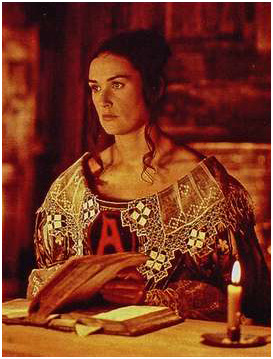
From using humans as resources to be bought and sold in the slave trade, to marketing in the colonial era, to modern day billboards, the concept of commodification of race has seen various forms throughout history. Browne notes one early version of the Banania brand package as having a carribean looking women pouring the product on a rejoicing French crowd. This marketing choice implies that the exotic region of the Caribbean is willfully giving the colonies and white people their resources. In reality we know this is not the case and that the nature of colonization was nothing but forceful. Similar representation has been seen today in billboard campaigns. For example, the picture below depicts a playstation advertisement promoting the release of the new white colored playstation with a powerful white women forcefully holding the face of a black person. This is overtly reminiscent of colonization and what Browne notes as the “white racial frame”. The frame which gives way to an anti-black frame categorizing difference where blackness is deemed unruly, needing to be tamed, as portrayed in the Playstation advertisement. As for the slave era, this was the justification for branding and characterizing blackness with negative characteristics in order to rationalize the violence.
Browne also brings up the point that certain memorabilia from the slave era has been commodified like the branding tool or certain historic photographs. As the amount of channels available for exposure has increased, commodity culture continues to show signs of branding blackness. For example, Nike’s campaign with Kaepernick and the various merchandise that came out of Angela Davis’ history as a power icon, show that branding the pain that black people endure is still relevant and pervasive and popular culture. To read more about the problematic act of branding black pain and these two specific cases, visit this site.
Photo #2: https://www.businessinsider.com/the-10-most-racist-ads-of-the-modern-era-2012-6#burger-king-and-mary-j-blige-got-blasted-for-this-fried-chicken-commercial-4

Branding blackness and the construction of prototypical whiteness also have consequence on surveillance and the practices of biometrics in regards to the recognition and verification that accompanies these practices.From the linear fashion in which artificial boundaries are regulated within biometric technology causing false identifications to the facial-scan system by video cameras being optimized for lighter-skinned users, I agree with Browne that as long as biometric technology relies on probability, surveillance in the US will remain racial and flawed. Once again reminiscent of the transatlantic slave trade when black people were separated by category of fit, people under surveillance are separated into stringent linear categories that deny subjectivity. From living in South Central Los Angeles, a predominately colored neighborhood, I know that this reality gives way to an inequality of surveillance as I note the frequently present helicopters technologically surveilling the streets from above. Will Smith’s quote in Browne’s article also notes that awareness of being under constant surveillance is an enduring condition of Black life. Furthermore, this article states that the government has reported its use of extensive surveillance resources to identify black activists they deem “extremists”. The article states that the “FBI thinks it can identify security threats by scrutinizing people’s beliefs and speech.” (Talbot, 2017) This is yet another example of people in power can socially construct someone’s identity and employ negative consequences in response. What frustrates me the most about this point is that surveillance technologies are known to advantage whiteness even though communities of color are surveilled more frequently.
To conclude these various arguments, Browne wants us to use these examples and realities of blackness to critically think about our history with punishment and torture as the borders of biometric technology increasingly close in on us.
2 notes
·
View notes
Photo

Latest story from https://movietvtechgeeks.com/chloe-sevigny-talks-lizzie-borden-kristen-stewart-sticking-passion-projects/
Chloe Sevigny talks 'Lizzie' Borden, Kristen Stewart and sticking with passion projects
Even if you don't know Chloe Sevigny from Larry Clark (Kids) and Harmony Korine's (Gummo) indie films of the 1990's, you more than likely have seen her on television in shows like Ryan Murphy's American Horror Story: Asylum or HBO's Big Love
Most film greeks were introduced to the versatile actress in her stunning (and shocking) debut as an HIV-infected teen in Larry Clark’s button-pushing drama Kids in 1995. Sevigny has portrayed nearly every type of character imaginable. The versatile actress/fashion icon has depicted the Midwestern girlfriend of a trans man in 1999’s Boys Don’t Cry, the dowdiest sister-wife of a polygamist on HBO’s series Big Love, a scheming Jane Austen social climber in 2016’s Love & Friendship, and even a legless nymphomaniac in FX’s American Horror Story.
Now she’s found a starring role to really sink her teeth, actually an ax into. In the heroine slaying the patriarchy film Lizzie (premiering in the U.S. Drama Competition), Sevigny takes on ax-wielding anti-heroine Lizzie Borden. Known to most as the parent-chopping up young woman from the famous rhyme, Borden allegedly murdered her father and step-mother at their home in Bedford Falls, Massachusetts in 1892, resulting in what was described as the “trial of the century” and eventually her acquittal.
Proving that passion projects are called 'passion' for a reason, this a role and film that Sevigny has shepherded to the screen after a decade in development. The payoff is huge as she delivers one of her most gripping performances that will likely have audiences on the edge of their seats.
Critics are already giving the film kudos, and it was our 'must see' choice at the 2018 Sundance Film Festival. Here's what Sevigny had to say about making the film, Kristen Stewart and the ten-year road for Lizzie. You’ve been attached to play Lizzie Borden for a decade as the project underwent various incarnations. Can you talk about the long journey to make this story into a feature film? Oh God, it’s so long and involved. [Laughs] It began the first time I visited the bed and breakfast in Fall River [the house where the murders took place is now a bed-and-breakfast/museum]. I was driving through Massachusetts with my boyfriend at the time, we were going to stay at the house and then go to Salem, for a spooky Halloween/romantic weekend getaway. As soon as I walked into that house, it was a moment that crystallized, and I knew I had to play this person. I felt so empathetic to her plight. Her story is so fascinating, because there are so many different theories and it’s still unsolved. The world has been fascinated by her for more than a hundred years now. She still inspires so many books, films, operas, and so many other things. She’s iconic as this misfit heroine. That was the moment that I realized I needed to do this. This is obviously a passion project. How did you begin the process of turning it into a movie? I was living with my friend Bryce Kass in Los Angeles as roommates. He was a struggling writer so I asked him to write it. He wrote an outline, and there was so much exposition, and we learned so many things––such as the police were at a picnic so many miles away. There were so many amazing details we could put in this story that it was hard to figure out how we wanted to do it. I was on Big Love at the time and very close to Peter Friedlander [a producer on the HBO series], so I took it to him, and he said we should pitch it to HBO. At that time—this was 10 years ago—they’d have given us more money and exposure and more people would see it on HBO than if it we made it as an indie film. That made more sense to me, you know? We pitched it, and it was there for a while. They held onto the material for a very long time. Bryce had to rewrite it as a miniseries. It was at various times a two-part miniseries and a three-part miniseries. Then they put us on the backburner over there and then picked us up again and had so many directors attached. In the end it just didn’t work out for us. We couldn’t pitch it to other networks for a variety of reasons that I had no idea about because I was so green to this whole process. The next time I’m going to have a lawyer that holds my hand through every step because it’s totally insane. But your endurance eventually paid off. Eventually, we had to reconceive it back to a feature and try to produce it independently ourselves. We set up a lot of meetings and sent it out to a lot of directors. I was attached and Kristen [Stewart] was kind of attached, so it’s hard to go to visionary directors who are working on their own projects when you already have actors attached. We watched Craig Macneill’s films and had conversations with him. He was actually from a place very near Fall River and had a very personal connection to Lizzie, so we decided to go with him. We found some independent financiers and set up some foreign sales and put it together. It came together really quickly. You were born in Massachusetts, which is Lizzie Borden country. When did you first become aware of her? I first became aware of her with the rhyme in probably junior high, or maybe I was younger. I didn’t know much about her. I was out one night for Halloween in the city, and one of my best friends was dressed as her for Halloween, so I delved into it. What was the appeal of her story for you? First of all, she was so misunderstood and didn’t have any real outlet. I was very empathetic to that. I wouldn’t say she’s crazy in any way, shape, or form. I just think she was disturbed. Playing a subtly disturbed person was something I’d never done before, and that interested me as an actor. What research did you do? I stayed at the house in Fall River several times. I went once on my own, once with Bryce, and once with the friend who had dressed up as Lizzie for Halloween. [Laughs] We went to her final resting place in Fall River and walked around Bedford. I went back with Craig and our cinematographer and art director to do more research at the Fall River Historical Society. It was very helpful in creating a fully realized version of her. We saw her objects, and they gave us permission to use a photo of her mother in the locket. I’ve read almost every book about her, and there are a lot. I actually read about different women at that time—even Emily Dickinson. There’s a great bio about her life and being imprisoned in her house, which gave me insight into what life was like in that period. My research was pretty extensive. You really exhibited palpable rage when you were swinging the ax. How do you prepare psychologically to play a scene like that? I’d prepared for that for 10 years now. I was naked in that scene, and now I’m sleepless every night. [Laughs] I’m 43 years old, and I can’t believe I did that. It’s not that I regret it because I wanted it to be very carnal and shocking, but now I feel pretty vulnerable, in all honesty. It’s my opinion and the writers’ that she did it and there are a lot of people who argue that she didn’t. There’s a theory that she went into an epileptic state of shock. Lizzie has a romantic relationship with Bridget, the live-in maid, played by Kristen Stewart. How fact-based is this? That’s not very fact-based. There are a lot of accounts of her having affairs with other women, especially Nance O’Neill, who was an actress. There are theories that that’s why she and Emma, her sister, didn’t speak to each other for the last years of their lives. We took liberty with that. There is evidence that Bridget was in cahoots and had to have been in the house [when the murders occurred]. Maybe those ladies did have one of the friendships that some women during that time period had, that were more intimate because they didn’t have anyone else. I think that after spending time in the house, we determined there was no way Bridget couldn’t have been in cahoots. It’s a film that’s time has come in more than one way. Both Lizzie and Bridget were abused by a man in the film. How do you think the film will resonate in today’s climate when the #MeToo and #TimesUp movements are calling out unacceptable behavior by men? Since all of this has happened recently, well, I mean I’ve always thought of this film as a smack in the face of the patriarchy. It’s extreme, and it’s violent and it smashes the face of the patriarchy. That was how I pitched it 10 years ago. Putting more women in power is the only way to protect young girls. I think men will always abuse them and the more they’re called out and held accountable the less likely they’ll be to act untowardly to women––so women need to be in more positions of power. That’s the only way to shift the dynamics. There’s more of a weight and importance to films now. Even like Beatriz at Dinner [her film which premiered at Sundance in 2017], which is about so many different things now. I’m really lucky to be a part of films that reflect what’s happening in today’s society. There’s been a call for Hollywood to hire more female directors. You’ve directed a couple of shorts. Do you plan to direct a feature eventually? I hope to. I’m making another short in April, which is about women and their relationship to the power. I’d like to direct a feature if I find the right material. It’s all about having the right material and being impassioned about what you want to say and what you want to do. I’ve worked with strong female directors like Kimberly Peirce on Boys Don’t Cry and Mary Harron on American Psycho. Whenever you have a project that you’ve just got to get out, it always elevates it. It enters into the zeitgeist and becomes something even bigger.
Movie TV Tech Geeks News
2 notes
·
View notes
Note
hey I'm a teenage girl and I'm just getting into this show and I feel like I'm not understanding how big it is/was? is there any modern day comparison you can make to help me understand? thanks! I love your blog!
First of all, I’m very sorry for the delay in answering you. Secondly, I’m so glad you like my blog and the show! I hope you are still enjoying both. And thirdly, I’m posting under a cut because this got ridiculously long, for which I apologize. I tried to give you a concise answer, I really did, but the question deserved so much more. If you hate reading long things, just ignore all my stuff and only read the quotes, which are blocked off. That should give you a pretty good idea anyway.
Your question is really good, but it’s a little tricky for me to answer, because I wasn’t actually alive when the show was first on the air. It’s also hard to answer because I assume you’re talking about the show’s cultural impact, and it’s sort of impossible to know what current show or movie is going to have that kind of impact 40 years from now.
But I think I would have to compare it to Wonder Woman. One of the reasons Wonder Woman is considered so important is that it had such a strong and well-rounded female protagonist, whose narrative revolves around her personal journey and not that of a man. It’s also the first really successful superhero movie about a woman, and that’s not a genre where you see very many female main characters, so the movie is sort of groundbreaking in that way. The Mary Tyler Moore Show is similar because, as far as I know, it was the first time a working woman was portrayed on television as the lead of her own sitcom, which was quite revolutionary. And Mary herself is really important because although she wasn’t perfect, she was a strong, mature, rounded female character who carried her own story - not unlike Diana Prince.
Here’s a quote about Wonder Woman from an article by Carrie Witmer:
The thing that matters most about “Wonder Woman” is the portrayal of Wonder Woman/Diana Prince herself. Gal Gadot’s Wonder Woman is a fully realized character. She’s emotional, confident, yet also insecure. She has hope and she has fear. She can love and lust and she can feel sadness and joy. She’s not just a beautiful face or hot body kicking ass.
Compare that to this quote about The Mary Tyler Moore Show, from a blog post by Erika Schmidt:
The Mary Tyler Moore Show was about a woman in her thirties living her life. Not within the context of her perfect marriage, or her continued wacky attempts to sneak into her husband’s show, or her quirky adventures as a mom/witch. It was, comparatively speaking, real. She worked, she dated. She threw terrible parties. Her friendships were of obvious and incalculable value. She was graceful, clumsy, timid, brave. She developed before our eyes. Mary Richards can’t be described in one sentence. And that is the point. That is what makes her a feminine icon.
The Wonder Woman comparison does break down a bit for a couple reasons: One, The Mary Tyler Moore Show actually drew a lot of heat from the feminist movement at the time, because people didn’t think it was going far enough. I haven’t seen any criticism of that sort about Wonder Woman, which doesn’t mean it doesn’t exist, but it doesn’t seem to be as common. Two, Wonder Woman is a movie set in World War 1, and The Mary Tyler Moore Show is a sitcom set in the decade in which it originally aired. So it’s not a good comparison in terms of format.
I don’t actually watch that many TV shows, but one of the few shows I do enjoy is Brooklyn Nine-Nine. B99 is a sitcom set in the workplace that regularly brings up social issues in a sort of low-key, subtle way, and that’s also what The Mary Tyler Moore Show did. The Mary Tyler Moore Show brought up issues like equal pay and birth control, whereas Brooklyn Nine-Nine brings up things like transphobia and racial profiling, but on either show, it’s rarely done in a way that makes the issue the focus of the episode. And that can be very powerful.
Here’s a quote from an article about Brooklyn Nine-Nine by Alyssa Rosenberg:
“Brooklyn Nine-Nine” has always been unusual in the series’ ability to find unpredictable routes into a wide range of issues in contemporary policing. In four seasons, it’s tackled everything from the New York Police Department’s history of racism and homophobia, to the abuse of internal affairs investigations, to how different city agencies work together, to how overzealousness can influence even a good cop’s judgement.
Compare that to this quote from an article about The Mary Tyler Moore Show by Alexis Sottile:
Over the course of the show’s seven seasons, Mary evolved with the times, tackling infidelity, birth control, sex, job promotions and the general human condition with the same mix of pluckiness, aplomb and oh-shit-do-I-really-have-to-do-this that made her an accessible role model for the new woman – and a sympathetic character for those that were scared of this new breed.
I’ll give a specific example: In season 3, there’s a brief reference to Mary taking the birth control pill. It was just a tiny snippet of dialogue, but it helped shift societal opinions on women being sexually active outside of marriage, which was still very controversial in the 70s’. The book “Mary and Lou and Rhoda and Ted” by Jennifer Keishin Armstrong includes this quote (p. 172) by Treva Silverman, who was one of the head writers on the show:
Mary was a “nice girl,” in quotation marks… If Mary was taking the Pill, it gave the stamp of approval for sexuality.
Treva Silverman, in case you didn’t know, is a woman. And that’s another huge impact the show had: It actively sought out female writers at a time when there was still a huge stigma against women in television production. (Here’s a good article about that.)
The show actually motivated lots of women to enter the field of television, and not just the women they hired to write for the show. Mary Richards was a very inspiring figure. Here’s a quote from TV journalist Katie Couric:
I don’t think I’d have this job if it weren’t for Mary Richards, and I mean that. They say if you can’t see it, you can’t be it, and when I saw Mary Richards make it on her own, driving that Mustang to that TV station in Minneapolis, I was in junior high, I thought, “Wow, I can have a career too.”
Oprah Winfrey, who was the first ever female African American billionaire, credits Mary Tyler Moore with having “more influence on [her] career than any other single person or force.” And “Mary and Lou and Rhoda and Ted” includes this quote from her (p. 283):
[The Mary Tyler Moore Show] was a light in my life, and Mary was a trailblazer for my generation. She’s the reason I wanted my own production company.
Even beyond the world of television and journalism, women were inspired. Here’s a quote from former First Lady Michelle Obama:
She was one of the few single working women depicted on television at the time. She wasn’t married. She wasn’t looking to get married… I was probably 10 or 11 when I saw that, and sort of started thinking, “You know what? Marriage is an option. Having a family is an option. And going to school and getting your education and building your career is another really viable option that can lead to happiness and fulfillment.”
And here’s a quote from another of the shows’ writers, Sybil Adelman Sage:
Before Mary Tyler Moore, it was acceptable to be a secretary, but not to be unmarried. Suddenly it was fine to be unmarried, and we were reaching for better jobs. Along with that blue beret, the rules had been thrown in the air. The show was arguably the most transformative sitcom in television history, forever changing how women were perceived.
Another notable, although less talked-about, influence the show had is that it revolutionized the sitcom format in general. If you’ve ever seen a realistic, character-driven comedy show with a strong cast of secondary characters, then you can thank The Mary Tyler Moore Show for making that format so popular. You can see that influence today in shows like The Office, Parks and Recreation, 30 Rock, The Mindy Project, Friends, and probably any other sitcom you can think of. (Here’s a good article about that.) I actually can’t think of a good modern-day comparison here because every sitcom I don’t know of anything that is visibly changing the television landscape as much as The Mary Tyler Moore show did in its time.
Here’s a quote from an article written by Jerry Buck as the show was entering its 4th season:
“The Mary Tyler Moore Show” took 20 years of pointless, insipid television situation comedy and spun it on its heels. The Moore show, going into its fourth year on CBS, pioneered reality comedy and the establishment of clearly defined and motivated secondary characters.
And according to this quote from a more recent article by Todd VanDerWerff:
Like [The Dick Van Dyke Show], Mary Tyler Moore would derive much of its comedy from its characters, rather than its punchlines. Where Moore went beyond Van Dyke came in just how thoroughly it embraced that template… [This] method of sitcom writing would, over time, become the dominant one. Even the least sophisticated sitcoms on TV now must at least pay lip-service to character complexity.
Another impact that the show had, and continues to have, is that it makes people happy. It’s just a really nice, positive, feel-good show. And that can be really important too. Here’s a quote from fashion designer Isaac Mizrahi:
[Mary Richards] proved to us again and again that if you put yourself into your world in the right way, if you pay attention to your own story, you can find the right people and the right place and be happy… The Mary Tyler Moore Show was one of the first examples of someone choosing her own family that we saw on television.
Honestly, I feel like I’ve only scratched the surface here. In case you’re not totally exhausted from reading all this and you’d like to read more on the subject, I’ve gone back through my blog and added an “impact” tag for you to look through if you’re interested. I should warn you that some of the posts reference specific episodes and that might be spoilers for you depending on where you’re at in the series.
Thanks again for your excellent question! If you have more questions or if you just want to chat, my askbox and private messaging system are always open for that.
7 notes
·
View notes
Text
Top 30+ Christmas Coloring Books for Adults
The snow is falling and the Christmas lights are beginning to go up so, after all, we have to have some Christmas Coloring Books to maintain us calm earlier than throughout and after Black Friday insanity.
Now that Coloring Books for Adults are an establishment, there are a complete lot of Christmas coloring books accessible together with Christmas Coloring Cards this yr. We have searched for essentially the most stunning selections for you. Please let me know within the feedback or on social media if I’ve neglected your favourite.
My Picks for Christmas Coloring Books for Adults 2019
My best choice this yr is the Queen of Colorings’ Christmas providing….
#1 JOHANNA’S CHRISTMAS by Johanna Basford
Something relatively particular for the festive season! Johanna’s Christmas is accessible NOW!
This e-book options 40 collectible, perforated pull-out prints, ultimate for framing or giving as presents. The excellent Christmas current for coloring followers. The illustrations are printed on one aspect of the ivory paper solely, to help you take away your murals with out sacrificing the picture on the reverse.
Delicate tangles of holly and ivy, bauble-laden Christmas timber and mountains of exquisitely wrapped presents are all ready to be dropped at life on this new assortment of pull-out prints. From flurries of delicate snowflakes to deliciously embellished gingerbread homes and reindeer-led sleighs, Johanna’s Christmas is a celebration of this excellent vacation season that invitations you to select up your pens and pencils to paint, full or embellish every of the festive artworks. Hidden on this e-book are a flock of elusive little robins – can you notice all of them?
US, UK & Canada Amazon Order Link or Book Depository (Free Shipping)
At Book Depository you may also snag the UK model which is a little bit totally different.
#2 Masja’s Christmas
Masja van den Berg is an artist within the Netherlands promoting her books on Etsy. Her pictures are magical and her books are all stunning hand-drawn and printed on single-sided on thick environment-friendly paper. If you buy $35 price of merchandise from her your transport to the US is free. If you enroll for her mailing record you’ll get the obtain of this cowl picture for free to paint. I’ve seen dozens of her pictures coloured on Instagram and have fallen in love. This is a model new e-book for 2019.
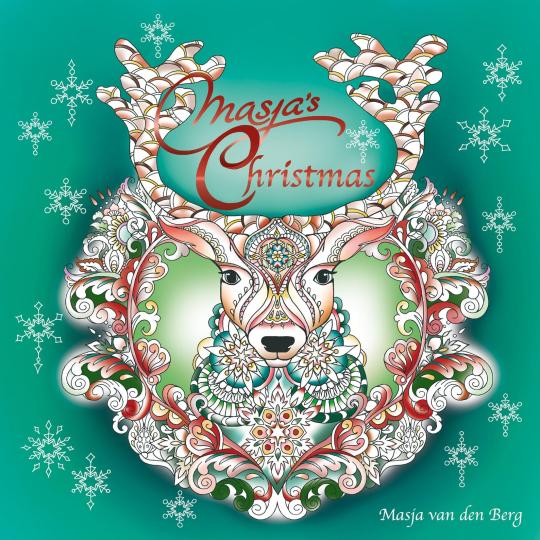
Click to Order on Etsy
#three Escape to Christmas Past by Good Wives & Warriors
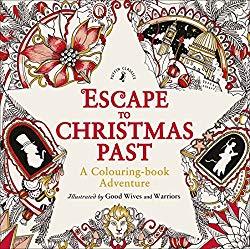
If you haven’t but found the Good Wives & Warriors design workforce you’re in for a deal with. I’m completely in love with the 5 books (plus one on pre-order) that I’ve acquired and coloured in. They are all two-sided coloring books with good paper for numerous mixing, layering and shading for coloured pencil followers and they’re smaller sq. books that help you end up a mission in a day or two of TV watching coloring.
Escape to Christmas Past is an homage to Charles Dickens’ “A Christmas Carol.” Evocative Christmas scenes and characters from Charles Dickens’ well-known story of Ebenezer Scrooge and Marley’s ghost, threaded with imaginative, delicate patterns all clearly outlined in pen and ink, make ultimate compositions to paint. Pivotal extracts from the story are scattered all through for inspiration, and there are areas left inside a number of the compositions for particular person design and embellishment. I promise you’ll adore this e-book.
Escape to Christmas Past Amazon US UK Canada Worldwide at Book Depository
#four Christmas to Color by Mary Tanana isn’t a brand new e-book however it was my favourite of 2015.
It has the proper mixture of conventional and eccentric, all hand-drawn with stunning thick white paper.
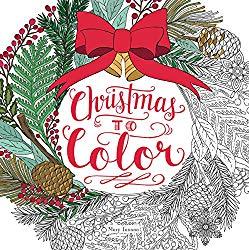
Order Christmas to Color on Amazon US, UK or Canada or Book Depository
#5 Sherri Baldy My-Besties Winter Snowmen Coloring Book
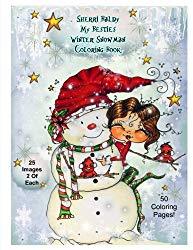
Sherri Baldy’s My Besties “Winter Snowman” Coloring Book is the primary time she has created vacation illustrations. Her enjoyable big-eyed snow folks besties are nice coloring for all ages, adults, and kids too. You get 50 coloring pages 2 of every picture is printed single~sided so you possibly can body or give away your colourful Bestie creations. This is a less complicated e-book than you’re used to with simply the lovable woman on the web page, so should you like them extra complicated, this isn’t the e-book for you, however such as you see within the image above it does offer you numerous area to play with background results, chalk, and stencils.
Order Christmas to Color on Amazon US, UK or Canada or Book Depository
#6 All Is Bright: A Devotional Journey to Color Your Way to Christmas
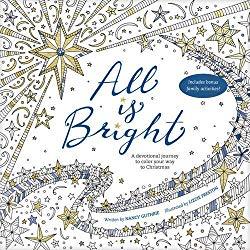
I simply acquired this beautiful coloring e-book from the writer Tyndale House and fully fell in love with it. It’s an Advent coloring count-down, prayer journal, bible examine, household exercise e-book all rolled into one. The illustrations by Lizzie Preston are simply stunning depicting totally different scenes concerning the season and accompanying commentaries by Nancy Guthrie lead you from December 1 – December 31. The again pages even include kid-friendly coloring pages alongside the identical theme because the e-book. Now let’s discuss concerning the paper, it’s wonderful! The good thick paper all of us love to paint on, the dimensions is the usual massive sq. 9.7 x 9.6. Check the YouTube channel for my flip by means of too.
Order All is Bright on Amazon US, UK or Canada Or Book Depository
#7 Mein Winterspaziergang
English translation is My Winter Walk, making this coloring e-book not particularly Christmas however it has numerous Christmas in addition to all through the winter climate scenes to paint. Rita Berman’s illustration fashion is sort of iconic and I’ll be you’ll develop into a fan and need all of her seasonal books. This e-book has 80 pages with a web page measurement smaller than the usual Johanna Basford measuring eight″ x eight″.
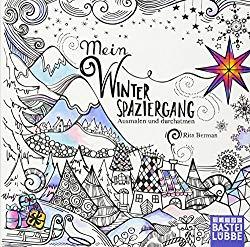
This German coloring e-book is new to the US coloring viewers this yr though it’s been accessible on Book Depository.
Click to Order Amazon US, UK or Canada or Worldwide at Book Depository
#eight Mounts 5 Christmas Coloring Book by Olya Goloveshkina
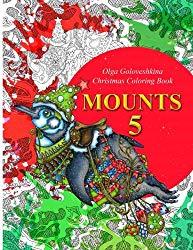
The e-book is crammed with 24 one-sided distinctive and fantasy detailed driving animals of artwork by artist Olya Goloveshkina. You can see a coloured model of this gorgeous chook in our Facebook group right here.
Click to order Amazon US, UK or Canada or Book Depository
#9 25 Days of Christmas by Jane F. Hankins
A stunning spiral certain coloring e-book with skilled paper depicting the 12 Days of Christmas, scenes from a Children’s Nativity, Sugar Plum Fairy and Santa’s Workshop on artists paper.
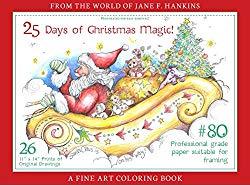
Click to Order Amazon US, UK & Canada
10. Nice Little Town Christmas 2 by Tatiana Bogema
Tatiana’s second e-book is crammed along with her unbelievably lovable mice within the setting of her iconic “Nice Little Town” all dressed up for Christmas.
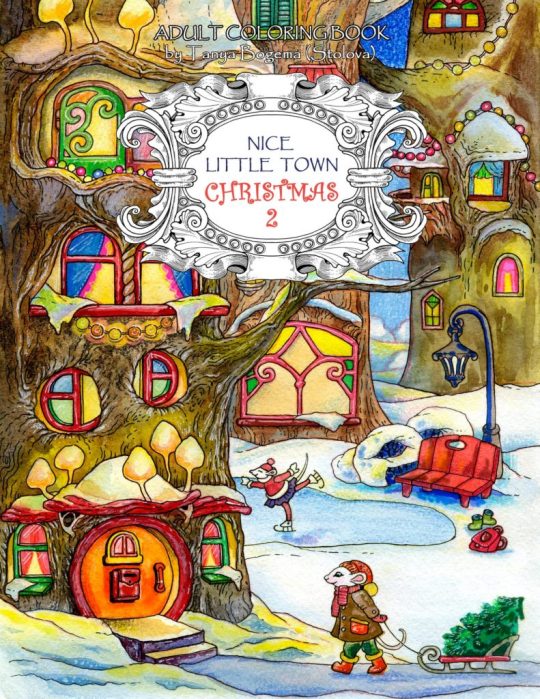
Click to Order Amazon US, UK or Canada or Digital Download on Etsy
#11 Home for the Holidays: A Hand-Crafted Adult Coloring Book for Christmas – Illustrator Galadriel A. L. Thompson

Home for the Holidays: Travel Edition
#12 Christmas Coloring Book (Coloring is Fun by Thaneeya McArdle)
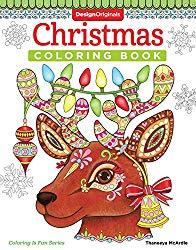
Click to Order Amazon US, UK or Canada
#13 A Christmas Carol – A Coloring Classic
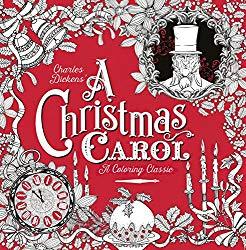
This e-book is simply GORGEOUS! 80 pages with a sewn binding, thick white paper printed on either side. Click to order A Christmas Carol Amazon US Amazon UK Amazon Canada
#14 A Million Christmas Cats by John Bigwood
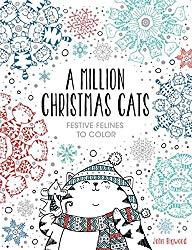
CLICK TO ORDER AMAZON US, UK OR CANADA
This is a smaller format than many of the books on this record however simply fabulous! Cats in all kinds of vacation and winter scenes, whimsical and enjoyable. It’s printed on either side with medium-thick paper, some with black backgrounds. I notably favored the cat’s ice-fishing web page.
#15 The Night Before Christmas Coloring Book

The solely gray-scale coloring e-book I’ve discovered with Christmas pictures and this one is simply GORGEOUS! Highly detailed web page by web page retelling of the well-known poem of the vacation season. If you will have by no means coloured in a gray-scale e-book they are surely fairly magical and you could find some recommendations and tutorials right here. This is a Dover e-book so the paper received’t be spectacular however you possibly can at all times copy the pictures to cardstock for presents or to border.
The Night Before Christmas is accessible on Amazon US – UK – Canada & Book Depository
#16 Santa’s Cats
By the illustrator of the favored “Cats & Quilts” coloring e-book, “Santa’s Cats” is a Christmas coloring e-book that comprises twenty-four timeless, distinctive illustrations of cats and kittens stepping into bother, serving to Santa and his elves as they put together for the large day, and cuddling up with Jolly Old St Nick after an exhausting day within the workshop on the North Pole.
Each image is printed on one aspect of 60 lb pure white paper to reduce scoring and bleed-through and seems in two sizes: massive and half-size (four″x6″), each appropriate for framing when accomplished.
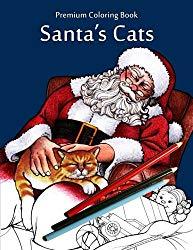
Santa’s Cats is accessible on Amazon US UK Canada and Book Depository
17. Color by Number Christmas Coloring by George Toufexis
George’s e-book is crammed with conventional Christmas vacation scenes and is secular in nature with issues like Santa, Christmas Trees, Stockings by the Fire and Winter Nature scenes. Images are printed on one aspect of the web page and are perforated. These 46 pictures are designed for skilled colorists.
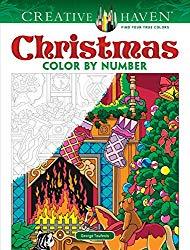
CLICK TO ORDER AMAZON US, UK OR CANADA
18. Christmas Magic Coloring Book by Deborah Muller
Deborah’s e-book has Fairies, Mermaids, Unicorns, Snowmen and Magic all wrapped up in vacation enjoyable.
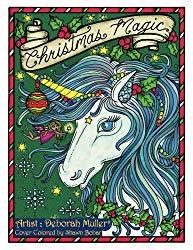
Click to Order Amazon US, UK or Canada Deborah additionally has one other Christmas e-book known as Fairy Merry Christmas that you simply may need to see.
19. The Magical Christmas – A Colouring Book“
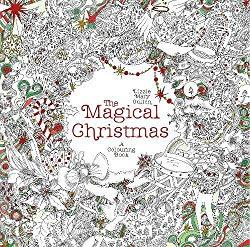
The Magical Christmas – A Colouring Book for Adults Illustrator Lizzie Mary Cullen This e-book may be very well-liked nevertheless I had a very exhausting time coloring in it because the illustrations are SO busy and detailed and drive you to paint just about each inch of the paper. Many of the pages have sections the place you aren’t certain what it’s you’re coloring or the place it stops and begins. I might advocate this solely for very skilled colorists who don’t frustrate simply.
Order Magical Christmas on Amazon US ~ Amazon UK ~ Amazon Canada or Book Depository
20. Whimsical Winter Wonderland by Molly Harrison
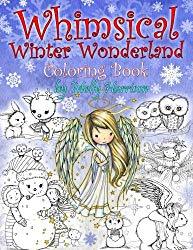
Click to Order Amazon US, UK or Canada or on Etsy right here
21. Christmas Coloring Book by Jade Summer
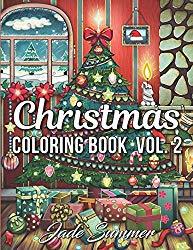
Click to Order Amazon US, UK or Canada
22. Merry & Bright
A Festive Christmas Coloring Wonderland of Snowmen, Ice Skates, and Quirky Critters on High-Quality Perforated Pages that Resist Bleed Through from numerous artists at Design Originals
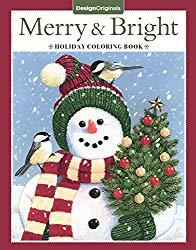
Click to Order Amazon US, UK or Canada
23. Snowflake Mandalas By Marty Nobel
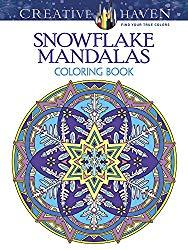
Click to Order Amazon US, UK or Canada
24. Christmas Designs by Peter Pauper Press
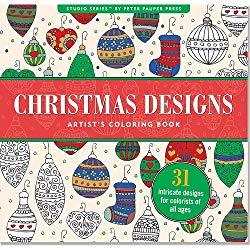
Click to Order Amazon US, UK or Canada
25. Christmas Joy
Christmas Joy is a coloring e-book crammed with 24 pages of great, cute pictures within the theme of Christmas hand-drawn by Swedish artist Sabine van Ee.

Click to Order Amazon US, UK or Canada or on Etsy Here
#26 Another of my favourite illustrators created a Christmas Coloring e-book “The Gift” unique title or “Night Voyage” for the English market
“The Night Voyage: A Magical Adventure and Coloring Book”
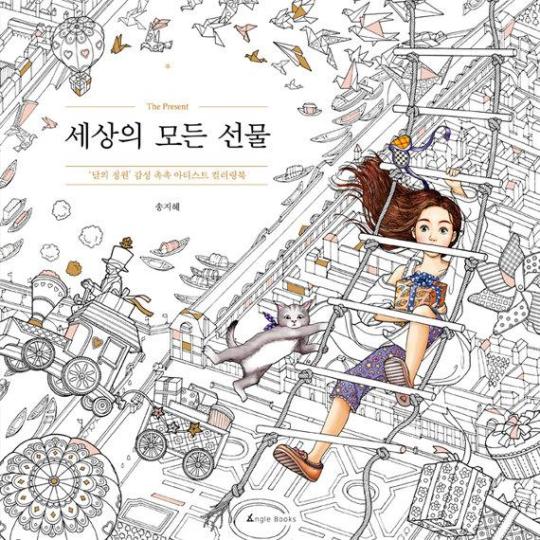
The Gift or All Gifts of the World or the Night Voyage are all alternate names for Daria Song’s Christmas e-book.
The tabby cat you see on this picture is all through the e-book for you cat lovers which might be additionally Daria Song followers. Her Christmas e-book follows the little woman on a brand new nighttime journey when the conductor of her toy practice involves life and helps her distribute presents the world over
This beautiful Christmas e-book is accessible to Order from Amazon US – UK – Canada or Book Depository Worldwide.
Tatiana is thought for her “Little Town” collection and this Christmas coloring e-book has a few of these lovable mouse home, little city kind illustrations however it additionally has different pictures and the one which received me over was the lovable gnome colorings I noticed a couple of occasions on Instagram. I contact the artist on Etsy and he or she answered me nearly instantly that I may discover that picture on this her first Christmas e-book. Honestly, at this value level and for the flexibility to immediately obtain and coloration I’ve already received it printed and also you’ll be seeing it posted on my social channels very quickly. I believe I additionally may shrink it down and make it into present tags. I could also be a little bit bit behind the occasions however Christmas gnomes are making me actually completely happy this yr.
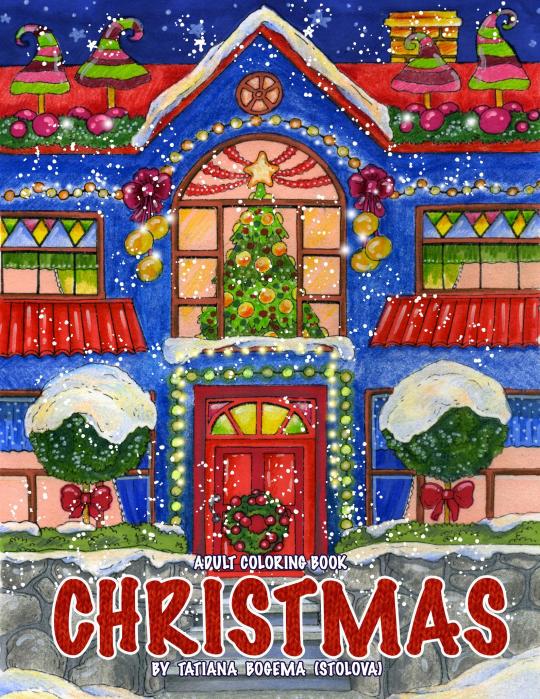
Click to order the Instant Download right here. Only $four.99
#28 Entangled Christmas Coloring Book
Angela Porter’s work is actually enjoyable to paint in. It has simply sufficient element to make it fascinating however not so tiny that you simply get fatigued with a web page. This is a Creative Haven e-book so pictures are printed on one aspect of the paper and are a vivid white good high quality paper.
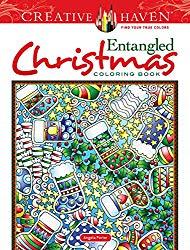
Click to Order Amazon US, UK & Canada
29. Sticker by Number Christmas
Something a little bit totally different, if these coloring fingers are getting drained, attempt your hand at Coloring by Sticker.

Click to Order Sticker By Number Christmas Amazon US, UK or Canada
Christmas Creative Haven Coloring Books
There are fairly a couple of Christmas Creative Haven & Dover Coloring Books which were round for some time so we’ll be including these titles as time permits.
Christmas Around the World -Joan O’Brien is the illustrator. This e-book is extra elementary than a number of the others however has some pretty conventional vacation pictures
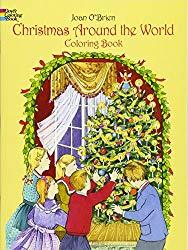
Nativity Stained Glass Coloring Book – Illustrator Marty Noble Christmas Mandalas – Illustrator Marty Noble Vintage Christmas Greetings Illustrator Marty Noble Winter Scenes – Illustrator Marty Noble Christmas Trees by Barbara Lanza Merry & Bright – Design Originals Illustrators An Old-Fashioned Christmas Coloring Book – Creative Haven My Besties Christmas Cottage Coloring Book – Sherri Baldy Ugly Holiday Sweaters – Creative Haven Winter Scapes Creative Haven Color Christmas Portable Book (Mini measurement) by Thaneeya McArdle Winter Wonderland with Love – Sherri Baldy Snowflake Mandalas – Marty Noble Night Before Christmas – Sherri Baldy Hebrew Illuminations Coloring Book: A Coloring Journey Through the Jewish Holy Days Adult Christmas Coloring Book: Magic Christmas: for Relaxation Meditation Blessing Nice Little Christmas Town by Tatiana Bogema Winter Magic: Beautiful Holiday Patterns Coloring Book for Adults Winter Wonderland – A Creative Haven e-book seems prefer it has some good winter scenes which might rejoice the vacations properly.
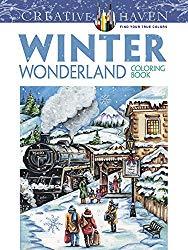
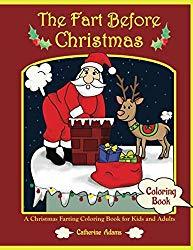
The Fart Before Christmas – A model new humorous coloring e-book that may be nice for school-age youngsters in addition to adults. This new coloring e-book is sort of intelligent and humorous. If you will have a school-aged kiddo or grandkid you understand that something to do with farting is at all times massively hilarious.
Click to Order Amazon US, UK & Canada
Johanna Basford’s Holiday Freebies
Johanna Basford has a number of Christmas and Holiday pictures on her web site which you can obtain for free and we count on her to do one thing enjoyable and particular once more in 2016. Here is her beautiful Christmas Star. Johanna knew she wanted to get the phrase out about her work a couple of years in the past and arrange a enjoyable twitter mission the place she tweeted a chunk of an introduction calendar every day on twitter. Luckily for you, it’s now all on this web page the place you possibly can click on on and print every picture to paint in at dwelling. My plan is to print these on good high quality paper, coloration and use them to make handcrafted Christmas playing cards.
Stocking Stuffer Favorites for the Holidays
Not certain how one can get began with Adult Coloring Books? Check right here for Where to Start with Adult Colouring and Top 13 Tips for New Colorists. Best Coloring Pencils, Gel Pens & Markers to make use of in Adult Coloring Books.
Check Book Depository for any which might be out of inventory on Amazon
If you understand of any others please contact me and let me know. If you’re an illustrator with a vacation mission for the 2019 or 2020 holidays please ship me a duplicate to evaluation so I can add it to my curated lists.
Check out Christmas Cards to Color right here, Christmas Coloring Instant Downloads on Etsy, and Jewish Holiday Books right here.
Join the enjoyable in our Christmas Coloring Contest from Jane F. Hankins 2019.
The post Top 30+ Christmas Coloring Books for Adults appeared first on XNX Adult Store.
0 notes
Text
Observations/Evaluations
My submission for this module was a collection of nine hand printed satin shirts. The subject matter that I chose for my final work took time to reach its definitive form. Originally I wanted to create my own line of hand made and hand tailored silk shirts, depicting a new range of designs and styles to that which I had created before. With my previous work I wanted to work around garments that embodied classic designs that never go out of fashion, starting with T-shirt’s, leading to denim jackets. For me these are classic staples that everybody owns, casual or designer. Their demand is as strong today as it ever has been and even more accessible with online retailers becoming more popular than the high street in the last five years. I strongly believe that Silk shirts are also a classic signature fashion statement, with an increasing popularity as online influencers give advice on how to style these shirts for a more casual or high fashion look. I believed that I could add something interesting to this market with both bold and subtle designs that allowed the properties of silk to accentuate the designs. I planned to create a large range of shirts to show off my branding and a variation of new and interesting designs.
I started having external lessons in how to make clothing from scratch and to tailor them according to body type. I thoroughly enjoyed this process and had taken to the new processes quickly, however due to COVID and the new lockdown enforcements I only had five sessions doing this. I wanted to use the equipment at university to print my own fabric with my designs on, then use the fabric to make my own seamless shirts for a more professional finish. I had to quickly adapt my plans for how I was going to conduct my final work. I decided that I would buy shirts in bulk and add my designs to these shirts in new methods.
I invested in an ink sublimation printer, specifically for fabric, along with a heat press machine to press my designs straight onto the already functioning shirt. I also quickly realised that silk shirts were considerably more expensive than satin shirts which gave the same visual and tactile effect. After bulk buying some satin shirts I began to experiment with the fabric sublimation inks and paper and found the comparison between the silk printing and satin printing to be practically identical so from a business perspective it became a more viable option financially. Satin is also a versatile fabric that can be worn in a multitude of ways from casual to high end which was an attractive element to me, with an aesthetically pleasing feel and look to the fabric. Most importantly satin proved to be an effective fabric to print on with sublimation ink giving a high quality finish. I searched online retailers to find the desired shirt style, and found that a high street chain sold oversized, long bodied satin blouses in a wide selection of colours and sizes. Once obtained I found these to be an ideal substitute for what I originally intended to make myself. I wanted an oversized fit as it was a personal preference along with increasing popularity on the market in the past few years. From a visual fashion and style perspective this was definitely what I wanted my products to look like.
I decided to change how I would display and organise these shirts into three mini ranges. This was to allow me to explore more than one theme in my work. A sketch based line, a sweets based line and a lockdown themed line. All relevant to my personal lockdown experience that I feel are marketable to a wider public. My project explores two main elements, my desire to successfully set up my own small arts business and my practical and artistic ability to create products for a fashion market with a clear commercial agenda. My body of work has developed considerably over the past few months through exploring what resources were available to me. I invested in an iPad Pro to develop my digital drawing process. This made my process quicker and easier; The designing/sketching, followed by the sampling and testing with sizing, materials and material colours. This then leads to the layout planning for the garment and the execution of the pattern printing. Although this process is straight forward It is initially time consuming as its all done by hand, however for multiple orders it would be quicker.
During lockdown I had many opportunities offered to me with commissioned work, giving me the most artistic freedom I’d had in a long time, Having commissions and conversations with individuals and companies. A friend of mine who happens to be the CEO of a successful marketing company was doing promotional work for a well know sweet brand called ‘Swizzels’. He asked me to design him some shirts that he could promote for his work. These shirts were incredibly successful and it made sense to me to carry on this theme in for my university work. Having the previous success showed me that these shirts sell, igniting me confidence in what I was producing and giving me more ideas on how I could explore and extend this range. As I started to explore line drawings more I began to compile sketches which I was then keen to print to see if the designs would work as shirt designs. Feedback was essential to how I moved forward with the editing process of my designs, working as a form of customer feedback which is extremely valuable to me starting out in an industry I’m new to. As the lockdown played such a huge part in my life these past four months I wanted to find some way of including it in my work. For my third range I wanted to combine my new love for line drawings with a light hearted COVID theme. Visuals that have been imprinted in my head from everyday life and working in hospitality as my day job. Signs, imagery and equipment that shares a clear themed message whilst still being light hearted and visually stimulating such as hand washing, soap and germs. I set out with these ideas to begin to produce these mini ranges with 3 shirts in each. In textile design, the trial and error element is a huge part in my making. Many elements have informed my decisions from what I had available to me and how my experiments helped/ hindered my making. Having made the heat press a large part of my making the experimentation process was a long one. There is no textbook on which heat settings and times will bring your image out at its best quality. This experimentation led me to find out which colours worked best on each colour of satin shirt, leading me to edit the ranges that I put out on which coloured shirts. Experimentation on all aspects from sizing and line thickness played a large part in the decisions I made to further my designs. It soon became clear to me that elements such as the availability of the shirts, sizes and colours were out of my hands, and that my work for my final exhibition could be based around the availability of the products that I could get my hands on. I also wanted to expand on the modelling of the shirts from my last module, however with the lockdown I realised it would be difficult to get others to model these shirts in a professional setting.
The Systematic and theoretical analysis of the methods that I have applied to my body of practice has allowed me to produce new work through new processes such as heat pressing and sublimation fabric ink printing all from home. This has allowed me to analyse and critique my work during all stages of the process to review and edit my methods. I have approached this module as a small business owner who is developing their ideas and products for the set up of their brand in a fashion and art market with emphasis on colour and bolder designs. I want to continue exploring current topics in my work, in a subtle and visually appealing way whilst continuing to produce collections of visually iconic, bright and bold designs. Through my experimentation with digital art during lock down, I wanted to incorporate some line drawing sketches that had been popular with my business social media audiences. I found these to be some of the most visually stimulating shirts made and have again sold out with reorders for many. I think I have been successful with my ideas and execution with clear communication as to what ideas my shirts display. selling my work and having interest in my designing process is important to my success and encourages me to continue in this line of work for my future career.
Artists such as Gemma Sheil who runs her own fashion house called ‘Lazy Oaf’ have been influential to me with her set up and her non apologetic attitude to produce the products that she wants to exist in her world, and has been incredibly successful doing so. The research done into her and her brand have influenced the development of my practice from designs to displays. Gemmas work excites me and encourages my own practice . Similar brands such as Monki have also influenced my interest in loud oversized satin shirts. Research into Luxury brands such a Gucci, Versace and Moschino have helped me to determine my own market, which I have established is heigh street, with the aimed target of reaching mainly women from 16-35 years. Textile designers such as Mary Katrantzou and Kristi O’mera have been interesting to research for their background in pattern design which is something I want to continue in my work. A future goal is to design, and print my own fabric and then hand tailor them into operational silk shirts reducing human error. This would allow me to cut my own shirt patterns whilst also ensuring accuracy and continuity, without imperfections.
My knowledge with textiles has helped me conquer this new process. The choice to use a white satin for my shirts allowed the vibrancy of my colour pallet to really accentuate my designs, leaving a visually bold, clear and glossy finish. This is how I wanted my shirts to look and through practical material testing, found the optimum measures to fulfil this. I have also found success with the packaging, allowing me to reach a final outcome that shows professionalism and clear branding that I am happy with. My practical research has been successful for me, through my tailoring lessons, I learnt a great deal in professionally tailoring and will continue when the opportunity arises. I learnt many new skills and methods such as pattern placing, overlooking and the process of assembly. My research into digital drawing softwares enabled me to produce clear and interesting designs that are marketable.
My current weaknesses also showed themselves through elements that I cant control such as my tailoring lessons that were postponed and elements such as which shirts were available to me and in which colours/sizes. I had intentions to have a professional photo shoot to display all of my products, with a selection of models in interesting placements and settings. However due to COVID restrictions this was not possible. I feel I could have researched more into my packaging, and with more time and funding I should be able to produce the luxury unboxing experience that I desire for my brand. Having said this I am happy and confident to use the packaging I have created for my products as I feel the exterior compliments the interior.
I have considered the audience in a number of ways with my product range as explored through my business plan. From sizing and fit to colours and prints. I wanted my audience to feel comfortable and bold at the same time and I feel I have achieved this. My current practice has informed my thought process and intentions for my career outside of university. I have clearly established that this is the career path I want to flourish in and this module has brought me a lot of clarity on what markets I aim my work towards, whilst also outlining what I am capable of producing.
0 notes
Text
Introduction
This anthology is designed to open people's eyes to the wonderfully creative culture that exists in Scotland. Creativity is a rather broad term, and in reality, so is this anthology. The creative works of Scotland come in multi-medium approaches as a way of expression. In this anthology, not only is there key pieces of works that are revolutionary, but also those that show the wide variety of creative endeavours this nation is capable of producing. These works focus on issues of identity, what it means to be a Scotsman, what makes a strong woman, and on the beauty and nature of Scotland. This cloudy and grey country has a lot more to offer than most people believe, and despite being a part of the United Kingdom, Scotland has a separate identity. The goal of this anthology is to showcase the beautifully unique culture and creativity of Scotland through various art forms, for example, poems, songs, novels, plays, and films.
The title of this anthology took some inspiration from the Government Agency entitled Creative Scotland, which supports and funds creative projects for Scottish artists. I thought it would be interesting to entitle my project the same, and our goals are quite similar. Even though I cannot financially support these endeavours, it does mean that I cannot give them a platform to receive further views and praise. The pieces in this collection are of importance to me, for not only showcasing the diverse talents of this small nation, but also for the lessons and messages they instil in the viewer. They remind me of the fond memories I have in Scotland, and remind me of how I long to go back. These works inspire me, and perhaps they can inspire other viewers as well.
To continue on the reasons for this anthology’s existence, I consider myself to be rather creative. As a young child, I always found myself more into arts and crafts rather than sports. In primary school, my best subjects were English, creative writing, and art class. I was always a dreamer, and found that the arts allowed me to express myself and my thoughts and feelings in a positive way. I grew up dancing, playing the violin and saxophone as well. I became musical, and developed a deep appreciation for music and those who played music or wrote music professionally. I dragged my mum to all the art museums I could, and she happily took me to see the Portland Symphony orchestra play. I was thirteen when I went to my first concert, and seeing live music became an addiction for me. The atmosphere was unlike anything I had ever experienced, a bunch of people from all different backgrounds coming together over a shared interest. That felt like black magic to me, how something so simple, so beautiful, could bring people together.
That is what this anthology does for me, it brings the creatives of Scotland together into one easy to navigate anthology. It features multi-medium works to show how the arts can have these bonding effects on humans. We are all brought together over commonalities, these works all provide a creative way to look at different art forms. Within these art forms, lies references to different art forms, which perpetuates the importance of creativity and the arts in general. However in this particular anthology, it perpetuates this importance not only in general, but also within the context of Scotland as a nation itself.
To begin, I picked the first work of Scottish writing I have ever had the pleasure of reading, Tam O’Shanter. This incredible poem highlights the beauty of the Scottish art of storytelling, and its importance to the Scottish culture. The first time I read this work, was in its original form which was written in Synthetic Scots. A language invented in order to preserve yet again another art form, the art form of language. Scotland was rapidly losing its distinct national language in favour of English. Burns felt that by expressing this story in synthetic Scots, he could perhaps demonstrate the need to preserve the Scottish language, or create a new one in order to keep the tradition, culture and language of Scotland alive.
Second up is Disney’s Brave, which showcases the Scottish culture to a massive worldwide audience. This film touched upon several important topics regarding Scottish culture, tradition and identity. Within the film, which is a creative art form itself, it depicts other art forms, such as weaving and the importance of weaving as a traditional art form within Scotland. Here storytelling also plays a large role, as the father constantly tells the story of the bear whenever he gets the chance.
Third is the poem In Praise of Old Vinyl by Liz Lochhead. This poem speaks towards to the feelings that music can invoke when you listen, and the importance of music in Scotland. Here specifically she talks about old vinyl, which is a vintage way to listen to music in these digital days. This calls upon the traditional nature of Scotland, and their appreciation for music in its best and most authentic forms. It also calls upon nostalgia, a theme often present in these various forms of art, as Scotland looks back on its rich traditions and history.
Fourth is the play Mary Queen of Scots Got Her Head Chopped Off also by Liz Lochhead. Granted I read this in book form, instead of watching it be performed by a theatre group, but I just had to add it. Mary Queen of Scots is an icon for Scotland, and putting this narrative into the form of play seemed genius to me. It furthers the tradition of storytelling, to the acting of these stories and histories out loud. The play provides the viewer a visual representation of the story with added music, and choreography to accompany it.
Fifth is the iconic song Barrowlands Ballroom by Amy MacDonald. The Barrowlands is the most iconic music and dance hall within Glasgow, and a key historical monument for Scotland. Glasgow in Scotland was the world’s first UNESCO world city of music, and the Barrowlands was known for being the centre of the music scene at the time. Here MacDonald sings an ode to the beloved concert venue, and acknowledges the other art forms this venue held. It holds concerts, dance nights, dancing competitions and open mic nights.
Sixth is another poem by Robert Burns entitled The Birks of Aberfeldy. I have been to the Birks of Aberfeldy myself twice, and have absolutely loved it both times. This poem highlights the beauty of nature and the picturesque landscape of the region. It is said to be the place where Burns often went to think, and brainstorm his ideas. This work highlights the usage of synthetic Scots once again, and focuses on the beauty of language and nature.
Seventh is the film Trainspotting directed by Danny Boyle. This film focuses on the underrepresented members of Scottish society, and the real issues surrounding Scotland. With an emphasis on heroin addiction, and the AIDS epidemic, this film highlights the reality of living in any society. Edinburgh used to be the #1 in Heroin usage in Europe, as well as the world capital for AIDS. It highlighted the aesthetics of heroin chic, which would later emerge into the grunge movement in fashion and of punk, indie and hard rock music.
Eighth happens to be the novel Trumpet by the Scottish Makar Jackie Kay. Her novel highlighted the importance of music, and it’s ability to make us feel and belong. Trumpet is about complex issues in gender identity, race and sexuality, as well as parent/child relations. Based on a true story, this novel provides us with another look at underrepresented communities within in Scotland, and allows us to explore the world of jazz music.
Ninth is the song I’m Gonna Be/500 Miles by the Proclaimers. This song became the anthem for our class trip to Scotland, and holds such fond memories within its lyrics for me. This love song speaks to the dreams of this man, and his hopes in order to be with the one that he loves. Dreams are an important goal that we create and imagine in our heads, the importance of imagination and hope are prevalent themes within this song.
Lastly, I wanted to end this anthology with my mixtape entitled Strong, Sexy and Scottish. It is an ode to powerful women in the music industry in Scotland. Music at first was an art form that was reserved for the men, and these women have taken a male dominated industry and become successful. This mixtape features songs that are about women's empowerment, equality, independence and love. I wanted to end with this mixtape to show something in which I have created. A collection of Scottish women I admire put together by a woman herself.
0 notes
Text
Review: DC House of Horror #1
My rating: 5 of 5 stars After reading five less-than-stellar Halloween-centric anthologies over the last few weeks, plus a hugely disappointing and long-awaited epic novel, I was feeling a bit burnt out on anthologies and prose in general. The time had come to catch up on some comics in the hopes of breaking out of my reading slump, and the title that most appealed to me just so happened to be -- wait for it! -- another anthology. But, fuck it. This is a comic book anthology, and only 80 pages at that (i.e. a quick read, plus a different format). I had high hopes going in, and this thing fucking delivered, giving me exactly what I had wanted in the wake of lingering disappointment and failure from previous anthologies. Working from plots by Keith Giffen, eight horror authors have assembled to script, and in some cases completely flip the script on, DC's most famous characters, putting them through the filter of various horror genre staples. We've got psychotic killers, ghosts, a slam-bang creature feature, and more in these eerie comics and tales to astonish. BUMP IN THE NIGHT by Edward Lee Edward Lee kicks off this anthology in grand fashion, delivering a Superman story that’s quite a far cry from the traditional big blue Boy Scout mainstay of DC lore. Howard Porter’s art serves this alien invasion story pretty well. It’s a bit rough looking and nicely suited for the dark night ahead at the Kent farm. This was a perfect way to open up this House of Horrors, and also serves as a nice warning to readers that these stories will most definitely not be your typical takes on DC Comics superhero icons. 5/5 stars MAN'S WORLD by Mary SanGiovanni Mary SanGiovanni scripts a magnificent and powerful Wonder Woman in a violent story of possession. It’s quick and dirty, and I loved the heck out of it. 'Nuff said. 5/5 stars CRAZY FOR YOU by Bryan Smith & Brian Keene Bryan Smith and Brian Keene pen a fun ol’ story of snapped sanity and a whole lotta murder. Bryan Smith needs to write more Harley Quinn, be it in-continuity or more horror, I don’t care, just get him to do more with this psycho gal. Kyle Baker’s art is a bit more roughly sketched than I usually care for, though, but I think it serves the story nicely, giving illustration to a man's frenetic mind. Good, good stuff right here. 4/5 stars LAST LAUGH by Nick Cutter Nick Cutter writing a Vincent Price-like Batman? Oh sweet baby Jesus, fuck yes. Here, Cutter tackles the psychology of a man dressed like a bat, perpetually chasing a crazy killer clown. Rags Morales does a great job illustrating this descent into madness, and I dug the little touches he and colorist Lovern Kindzierski added to show the differences between the characters viewpoints. 4/5 stars BLACKEST DAY by Brian Keene Brian Keene blazes hell with the Justice League as they square off against an apocalyptic outbreak on Earth while trapped in their Watchtower moon base. It’s a fun, fast-paced story with plenty of carnage. Scott Kolins does a good job with the art duties, and there’s a good amount of guts spilled under his pencils. I've also got a particular hankering from some Keene-written Constantine now, because how awesome would that be? (The answer, by the way, is very. Hint, hint, DC Comics!) 4/5 stars STRAY ARROW by Ronald Malfi In the DC Rebirth, Green Arrow is a self-described Social Justice Warrior. Under Malfi's hand, he's a cold blood pscyho killer, in a city that drives its inhabitants insane. I had expected so much more from this pairing between author and superhero, and I think it could have been a lot better if the story’s femme fatale had gotten more room for development. The premise is dynamite, and I wish there had been more room to deliver on some of the story elements it hints at. Still, it's worth it for the wildly different spin on these familiar faces. 3/5 stars UNMASKED by Wrath James White Holy shit, y'all. A serial killer and a giant monster are tearing apart Gotham in Wrath James White’s story. From the story's opening narration about a victim who has been degloved, I knew I was going to be right at home here. There’s a lot of craziness jammed into a handful of pages, and artist Tom Raney really knocks it out of the park with his delivery of the script's biggest shocker scene. God damn, I loved this one! 5/5 stars THE POSSESSION OF BILLY BATSON by Weston Ochse Words have power and, in Weston Ochse’s script, one word in particular haunts Billy Batson. Howard Chaykin depicts 1970s New York and a punk-rocker-styled Batson with flair, keeping the story’s keyword in both the background, and front and center. Unfortunately there’s not a lot of depth to the story and it ends pretty abruptly. I must admit, though, I am not very familiar with the character in question here, which may have hindered my enjoyment a bit. The saving grace for me was the period-setting and how well rendered it was by Chaykin. 3/5 stars Although I didn't flat-out love every story in DC House of Horror #1, I found all of them to make for a fun reading, and the ones that I loved, I loved deeply. Keene and Company put some truly wonderful and unexpected twists on DC Comics staples, bringing in oodles of darkness, morbidity, and depravity (or at least as much DC has allowed them to get away with. I would absolutely love to see House of Horror continue as a Mature Readers or Vertigo title.). For sheer entertainment value alone, and the consistency of goods delivered throughout,, this one gets a five-star from me. This is the most flat-out fun read of October. View all my reviews
#House of Horror#DC House of Horror#horror#comics#comic book#comixology#Brian Keene#Edward Lee#Mary SanGiovanni#Nick Cutter#Bryan Smith#Ronald Malfi#Wrath James White#Weston Ochse#anthology#superman#batman#justice league#book review#book reviews#book blogger
0 notes